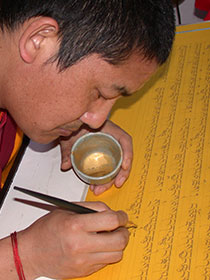- Home
- FPMT Homepage
Foundation for the Preservation of the Mahayana Tradition
The FPMT is an organization devoted to preserving and spreading Mahayana Buddhism worldwide by creating opportunities to listen, reflect, meditate, practice and actualize the unmistaken teachings of the Buddha and based on that experience spreading the Dharma to sentient beings. We provide integrated education through which people’s minds and hearts can be transformed into their highest potential for the benefit of others, inspired by an attitude of universal responsibility and service. We are committed to creating harmonious environments and helping all beings develop their full potential of infinite wisdom and compassion. Our organization is based on the Buddhist tradition of Lama Tsongkhapa of Tibet as taught to us by our founders Lama Thubten Yeshe and Lama Thubten Zopa Rinpoche.
- Willkommen
Die Stiftung zur Erhaltung der Mahayana Tradition (FPMT) ist eine Organisation, die sich weltweit für die Erhaltung und Verbreitung des Mahayana-Buddhismus einsetzt, indem sie Möglichkeiten schafft, den makellosen Lehren des Buddha zuzuhören, über sie zur reflektieren und zu meditieren und auf der Grundlage dieser Erfahrung das Dharma unter den Lebewesen zu verbreiten.
Wir bieten integrierte Schulungswege an, durch denen der Geist und das Herz der Menschen in ihr höchstes Potential verwandelt werden zum Wohl der anderen – inspiriert durch eine Haltung der universellen Verantwortung und dem Wunsch zu dienen. Wir haben uns verpflichtet, harmonische Umgebungen zu schaffen und allen Wesen zu helfen, ihr volles Potenzial unendlicher Weisheit und grenzenlosen Mitgefühls zu verwirklichen.
Unsere Organisation basiert auf der buddhistischen Tradition von Lama Tsongkhapa von Tibet, so wie sie uns von unseren Gründern Lama Thubten Yeshe und Lama Thubten Zopa Rinpoche gelehrt wird.
- Bienvenidos
La Fundación para la preservación de la tradición Mahayana (FPMT) es una organización que se dedica a preservar y difundir el budismo Mahayana en todo el mundo, creando oportunidades para escuchar, reflexionar, meditar, practicar y actualizar las enseñanzas inconfundibles de Buda y en base a esa experiencia difundir el Dharma a los seres.
Proporcionamos una educación integrada a través de la cual las mentes y los corazones de las personas se pueden transformar en su mayor potencial para el beneficio de los demás, inspirados por una actitud de responsabilidad y servicio universales. Estamos comprometidos a crear ambientes armoniosos y ayudar a todos los seres a desarrollar todo su potencial de infinita sabiduría y compasión.
Nuestra organización se basa en la tradición budista de Lama Tsongkhapa del Tíbet como nos lo enseñaron nuestros fundadores Lama Thubten Yeshe y Lama Zopa Rinpoche.
A continuación puede ver una lista de los centros y sus páginas web en su lengua preferida.
- Bienvenue
L’organisation de la FPMT a pour vocation la préservation et la diffusion du bouddhisme du mahayana dans le monde entier. Elle offre l’opportunité d’écouter, de réfléchir, de méditer, de pratiquer et de réaliser les enseignements excellents du Bouddha, pour ensuite transmettre le Dharma à tous les êtres. Nous proposons une formation intégrée grâce à laquelle le cœur et l’esprit de chacun peuvent accomplir leur potentiel le plus élevé pour le bien d’autrui, inspirés par le sens du service et une responsabilité universelle. Nous nous engageons à créer un environnement harmonieux et à aider tous les êtres à épanouir leur potentiel illimité de compassion et de sagesse. Notre organisation s’appuie sur la tradition guéloukpa de Lama Tsongkhapa du Tibet, telle qu’elle a été enseignée par nos fondateurs Lama Thoubtèn Yéshé et Lama Zopa Rinpoché.
Visitez le site de notre Editions Mahayana pour les traductions, conseils et nouvelles du Bureau international en français.
Voici une liste de centres et de leurs sites dans votre langue préférée
- Benvenuto
L’FPMT è un organizzazione il cui scopo è preservare e diffondere il Buddhismo Mahayana nel mondo, creando occasioni di ascolto, riflessione, meditazione e pratica dei perfetti insegnamenti del Buddha, al fine di attualizzare e diffondere il Dharma fra tutti gli esseri senzienti.
Offriamo un’educazione integrata, che può trasformare la mente e i cuori delle persone nel loro massimo potenziale, per il beneficio di tutti gli esseri, ispirati da un’attitudine di responsabilità universale e di servizio.
Il nostro obiettivo è quello di creare contesti armoniosi e aiutare tutti gli esseri a sviluppare in modo completo le proprie potenzialità di infinita saggezza e compassione.
La nostra organizzazione si basa sulla tradizione buddhista di Lama Tsongkhapa del Tibet, così come ci è stata insegnata dai nostri fondatori Lama Thubten Yeshe e Lama Zopa Rinpoche.
Di seguito potete trovare un elenco dei centri e dei loro siti nella lingua da voi prescelta.
- 欢迎 / 歡迎
简体中文
“护持大乘法脉基金会”( 英文简称:FPMT。全名:Foundation for the Preservation of the Mahayana Tradition) 是一个致力于护持和弘扬大乘佛法的国际佛教组织。我们提供听闻,思维,禅修,修行和实证佛陀无误教法的机会,以便让一切众生都能够享受佛法的指引和滋润。
我们全力创造和谐融洽的环境, 为人们提供解行并重的完整佛法教育,以便启发内在的环宇悲心及责任心,并开发内心所蕴藏的巨大潜能 — 无限的智慧与悲心 — 以便利益和服务一切有情。
FPMT的创办人是图腾耶喜喇嘛和喇嘛梭巴仁波切。我们所修习的是由两位上师所教导的,西藏喀巴大师的佛法传承。
繁體中文
護持大乘法脈基金會”( 英文簡稱:FPMT。全名:Found
ation for the Preservation of the Mahayana Tradition ) 是一個致力於護持和弘揚大乘佛法的國際佛教組織。我們提供聽聞, 思維,禪修,修行和實證佛陀無誤教法的機會,以便讓一切眾生都能 夠享受佛法的指引和滋潤。 我們全力創造和諧融洽的環境,
為人們提供解行並重的完整佛法教育,以便啟發內在的環宇悲心及責 任心,並開發內心所蘊藏的巨大潛能 — 無限的智慧與悲心 – – 以便利益和服務一切有情。 FPMT的創辦人是圖騰耶喜喇嘛和喇嘛梭巴仁波切。
我們所修習的是由兩位上師所教導的,西藏喀巴大師的佛法傳承。 察看道场信息:
- FPMT Homepage
- News/Media
-
- Study & Practice
-
-
- About FPMT Education Services
- Latest News
- Programs
- New to Buddhism?
- Buddhist Mind Science: Activating Your Potential
- Heart Advice for Death and Dying
- Discovering Buddhism
- Living in the Path
- Exploring Buddhism
- FPMT Basic Program
- FPMT Masters Program
- FPMT In-Depth Meditation Training
- Maitripa College
- Lotsawa Rinchen Zangpo Translator Program
- Universal Education for Compassion & Wisdom
- Online Learning Center
-
- Prayers & Practice Materials
- Overview of Prayers & Practices
- Full Catalogue of Prayers & Practice Materials
- Explore Popular Topics
- Benefiting Animals
- Chenrezig Resources
- Death & Dying Resources
- Lama Chopa (Guru Puja)
- Lama Zopa Rinpoche: Compendium of Precious Instructions
- Lama Zopa Rinpoche: Life Practice Advice
- Lama Zopa Rinpoche Practice Series
- Lamrim Resources
- Mantras
- Prayer Book Updates
- Purification Practices
- Sutras
- Thought Transformation (Lojong)
- Audio Materials
- Dharma Dates - Tibetan Calendar
- Translation Services
- Publishing Services
- Ways to Offer Support
- Prayers & Practice Materials
-
- Teachings and Advice
- Find Teachings and Advice
- Lama Zopa Rinpoche Advice Page
- Lama Zopa Rinpoche: Compendium of Precious Instructions
- Lama Zopa Rinpoche Video Teachings
- ༧སྐྱབས་རྗེ་བཟོད་པ་རིན་པོ་ཆེ་མཆོག་ནས་སྩལ་བའི་བཀའ་སློབ་བརྙན་འཕྲིན།
- Podcasts
- Lama Yeshe Wisdom Archive
- Buddhism FAQ
- Dharma for Young People
- Resources on Holy Objects
- Teachings and Advice
-
-
*If a menu item has a submenu clicking once will expand the menu clicking twice will open the page.
-
-
- Centers
-
- Teachers
-
- Projects
-
-
-
-
*If a menu item has a submenu clicking once will expand the menu clicking twice will open the page.
-
-
- FPMT
-
-
-
-
-
My religion is kindness to all
His Holiness the Dalai Lama
-
-
-
- Shop
-
-
-
The Foundation Store is FPMT’s online shop and features a vast selection of Buddhist study and practice materials written or recommended by our lineage gurus. These items include homestudy programs, prayers and practices in PDF or eBook format, materials for children, and other resources to support practitioners.
Items displayed in the shop are made available for Dharma practice and educational purposes, and never for the purpose of profiting from their sale. Please read FPMT Foundation Store Policy Regarding Dharma Items for more information.
-
-
FPMT Community: Stories & News
16
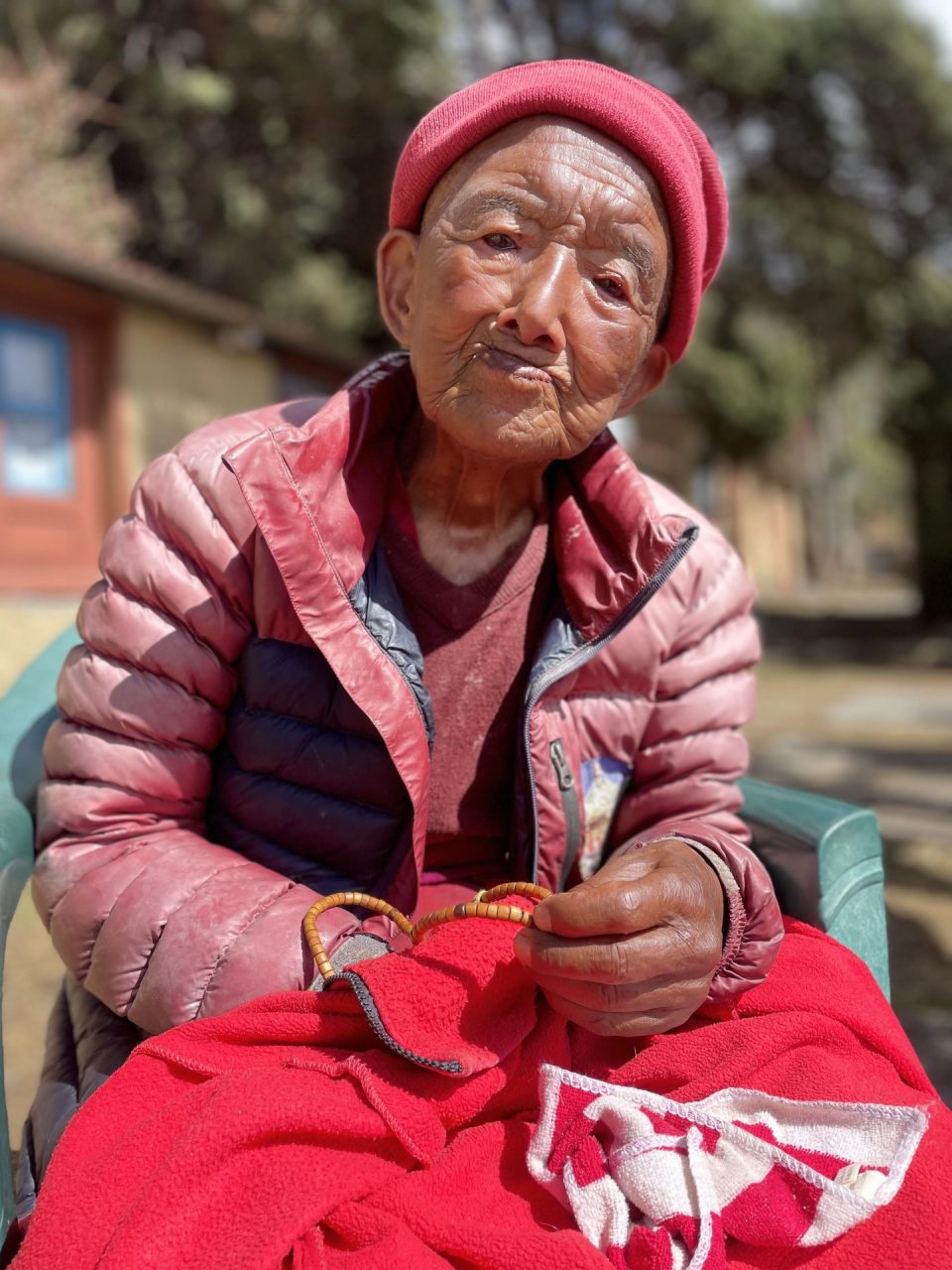
Ven. Ngawang Yonten, “Ashang,” 2023. Photo by Ven. Sarah Thresher.
Lama Zopa Rinpoche’s uncle, Ven. Ngawang Yönten (affectionately known as Ashang, which means, “maternal uncle”) passed away peacefully at Lawudo, Nepal, on the morning of July 7, 2024. He was 98 years old and most likely one of the last of the local Sherpas to have known both Lawudo Lamas. Please read this beautiful account of Ashang’s life, written by Ven. Sarah Thresher with input and details from Anila Ngawang Samten, Gelong Ngawang Nyendak, Jamyang Wangmo (including consultation of The Lawudo Lama), and Ven. Tsultrim,
To visitors at Lawudo, Ashang was a constant presence at the lower retreat huts where he recited mantra continually from morning to night, stopping only to eat, sleep or go to the bathroom. He seemingly had no attachment to worldly things and Rinpoche would often fondly relate stories from his life of practice (see The Lawudo Lama).
Ashang was born in Thame in 1926, the Year of the Tiger. He was the youngest of six children—three girls and three boys—and his father (Rinpoche’s grandfather) died while he was still in the womb. Lama Zopa Rinpoche’s mother, Nyima Yangchen was the eldest child in the family. The family had five yaks and when he was young he would take care of them, bringing them up to Tengbo, and also help Rinpoche’s father with their yaks. When Rinpoche’s father passed away leaving the mother with three small children, he helped as much as he could.
In 1955, when he was in his late 20s, Ashang became very sick and nobody could help. Two years later when Rinpoche’s uncles decided to go to Tibet for pilgrimage, Ashang also came along, bringing their luggage on his five yaks as far as Dingri Ganggar. There he went to see a famous Tibetan doctor, but the doctor couldn’t help him. After visiting another doctor who also couldn’t cure him, he decided to go to Dza Rongphu to see Trulshik Rinpoche. Trulshik Rinpoche advised him that his sickness was due to karmic obscuration and could not be cured by medicines but only through purification practices. Ashang requested to be ordained as a monk and Trulshik Rinpoche advised him to do the preliminary practices first. Ashang stayed six months at Rongphu receiving teachings and then took getsul vows. He returned to Khumbu with his five yaks loaded with salt and decided to sell the animals and devote himself fully to Dharma practice.

Ashang, Amala (Rinpoche’s mother) and Ani Ngawang Samten (Rinpoche’s sister) in 1983.
As the youngest son, Ashang was responsible to take care of his mother (Rinpoche’s grandmother) who was now old and blind and could not be left alone. He obtained permission from Charok Lama Kushog Mende to build a small hut under the cliff at Charok and he moved there with his mother. The hut was very small so Ashang would spend the night in a small square meditation box while his mother slept on a wooden bench next to the fireplace. He did prostrations on a wooden board outside the hut. In addition to his own Dharma practice, he did all the cooking, collected firewood and fetched water because his mother could do nothing except recite mani mantras.
Ashang spent eleven years in that hermitage and completed seven sets of the preliminary practices (prostrations, Vajrasattva, mandala offerings, guru yoga) while caring for his mother. Over the years his health improved so much that he never got sick again. His main teacher at that time was Gelong Ngawang Samten, a very pure practitioner who lived in a cave at Charok a short distance from the hut.
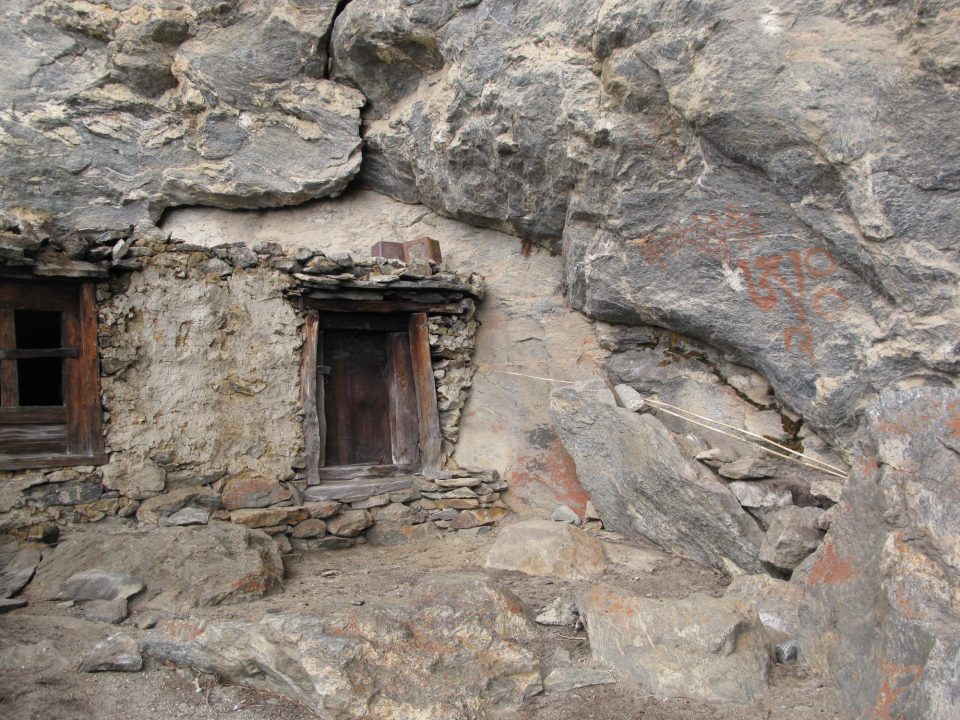
Ngawang Yonten’s hermitage in Charok where he spent many years doing prostrations.
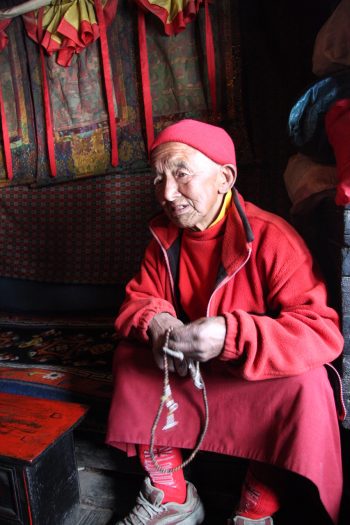
Ashang in his hermitage in Thame gompa, 2013. Photo by Merry Colony.
Later, Ashang bought a house from a nun at Thame gompa which he fixed up and then moved there with his mother till she died.
When Rinpoche returned to Khumbu as the Lawudo Lama, Ashang helped Rinpoche’s mother and sister with the building work and whatever else was needed to establish Lawudo Gompa until Tsultrim Norbu was sent up from Kopan; he also gave his own fields in Mende to Lawudo. Ashang also taught Tibetan to Rinpoche’s sister and brother when they were young, and later to Rinpoche’s niece, who is now a Geshema at Kopan nunnery. Ashang was always helping.
Following the earthquake of 2015, when Ashang’s house was damaged and his health deteriorating, Rinpoche advised him to come to Lawudo and asked Anila Ngawang Samten to take care of him. It’s said that when he left Thame Gompa for Lawudo everyone was crying because they all loved him so much. He was so humble and kind. During a video call in January 2023, Rinpoche told Ashang he had no need to worry at the time of death because he would definitely have a very good rebirth.
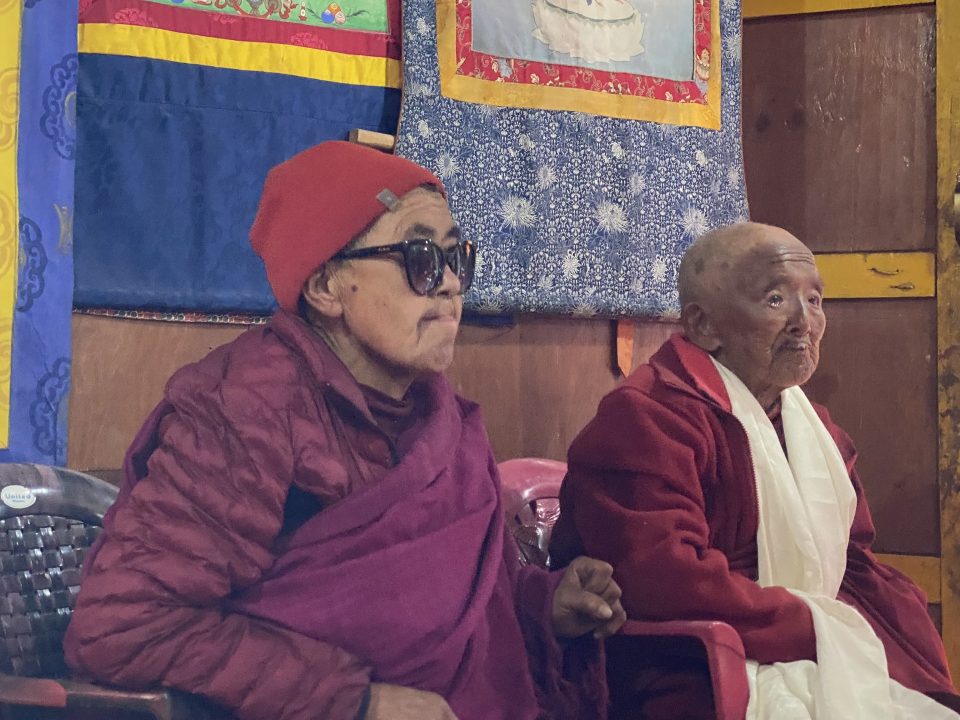
Ashang with Anila Ngawang Samten at a puja immediately after Lama Zopa Rinpoche’s passing, April 2023. Photo Alison Murdoch
At the time of passing, Ashang was very strong and clear in his mind and the next day, Ngawang Nyendak came to recite the prayers for him. The Thame monks along with Charok Lama performed the fire offering rituals with full respect, dressing Ashang in the attire of the Sambogakaya, honoring him as the most senior Thame monk and for his lifetime of practice. It was a very moving ceremony and many locals came from around the valley to help and pay respects. Pujas were also sponsored for Ashang at Kopan and Thubten Choling
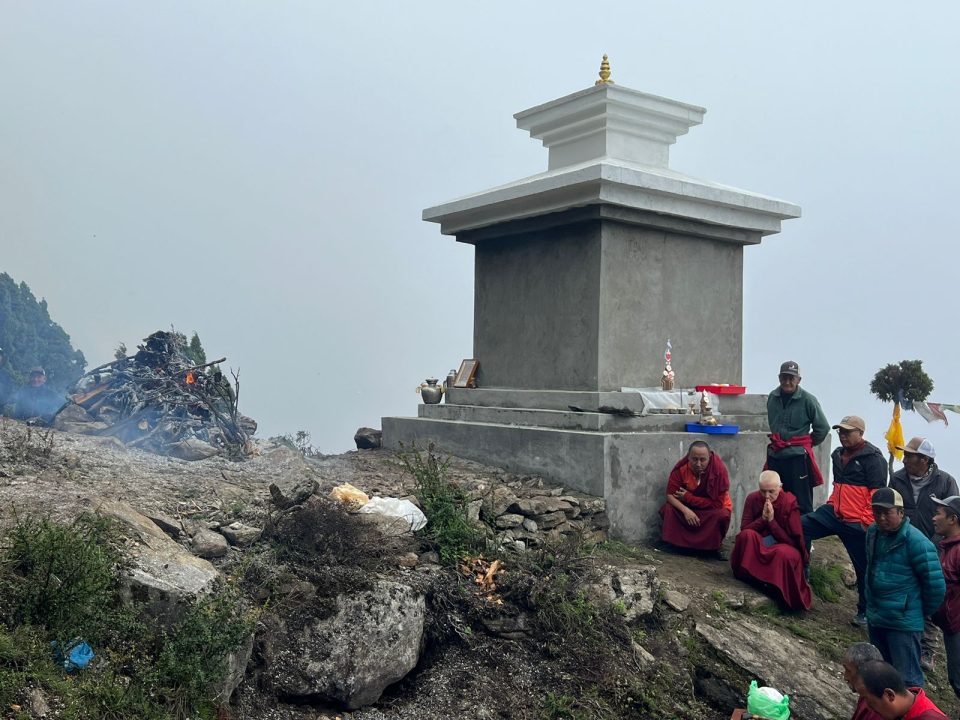
Cremation of Ven. Ngawang Yonten at Lawudo, July 9, 2024.
You can watch a playlist of short video clips of Ashang’s cremation, which occurred on Chokhor Duchen, July 9, 2024.
With tremendous thanks to Anila Ngawang Samten, Gelong Ngawang Nyendak, Jamyang Wangmo, Ven. Tsultrim, Merry Colony, and Alison Murdoch for their contributions and photos.
Please pray that Ven. Ngawang Yonten may never ever be reborn in the lower realms, may he be immediately born in a pure land where he can be enlightened or to receive a perfect human body, meet the Mahayana teachings and meet a perfectly qualified guru and by only pleasing the guru’s mind, achieve enlightenment as quickly as possible. More advice from Lama Zopa Rinpoche on death and dying is available, see Death and Dying: Practices and Resources (fpmt.org/death/).
To read more obituaries from the international FPMT mandala, and to find information on submission guidelines, please visit our new Obituaries page (fpmt.org/media/obituaries/).
- Tagged: obituaries, obituary
5

Anila Ngawang Samten and Charok Lama, Lawudo ,May 2024. Photo by Kristina Mah.
Last month we shared a moving report about the recent pilgrimage to Lawudo, marking the first anniversary of the passing of Lama Zopa Rinpoche, where 38 students from around the world visited and made heartfelt prayers at the holy places of the Lawudo Lamas—Rinpoche and his previous life as Lawudo Lama Kunsang Yeshe. During the pilgrimage, which occurred from April 24-May 8, 2024, Charok Lama and the pilgrims offered Lama Chopa puja in the Lawudo gompa with Lama Zopa Rinpoche’s sister, Anila Ngawang Samten on May 3. This day also commemorated Anila’s eighty-third birthday and Charok Lama took the opportunity to offer some words about her and sharing his own personal history with her. Here we share a video of this talk given by Charok Lama and also a lightly edited transcript:
Charok Lama Praising Anila Ngawang Samten:
https://www.youtube.com/watch?v=kDpoRL1SITc
Anila has put great effort throughout her life into Lawudo and this itself is such a beautiful practice. We thank her for what she has done, for how long she has done it, and praise her for her spirit and strength. Even now you can see how strong the passion that runs in her is.
Anila has put a lot of … what is the word for that? There is actually no word for it. She has offered her entire life for Kyabje Lama Zopa Rinpoche and for this place. Anyone who visits can see how hard life is in these conditions. For me, my life has gone very, very smoothly. If I ended up in any other way, I probably would have ended up here, maybe as a porter. My mum was a porter. So it’s very likely that would have happened to me.

Anila Ngawang Samten photo montage by Kristina Mah.
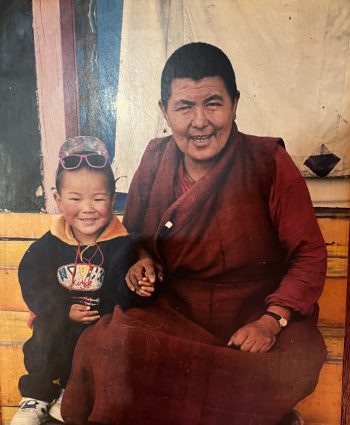
Anila Ngawang Samten with two-year old Charok Lama, December 1995, in Lawudo. Photo by Frances Howland.
Anila has played a big, big role in my life; not that I remember a lot of it; but I can feel it. We all heard the story yesterday. She has many, many, many more stories. If you are willing to sit down and listen to her, she can go on and on for the whole day. She keeps them at heart, that’s one of the most beautiful things about Anila.
She keeps everything at heart. For people like us, being able to see someone like her— so passionate about sustaining this place — is a blessing. People like us, we change, we jump. Ten years we want to do this, ten years later we want to do that, after five years over there, after six years over there. We are all over the place. Anila is the total opposite. People tried to take her here, they tried to take her over there. They have taken her down, offered her a good house, very comfortable; an easy life , a good bed, good toilet with an attached bathroom, yet all that means nothing to her. There is no craving for the same things we look for. When I think about it, Anila is a great teacher to learn from. She is an amazing teacher in that sense — in a very particular way, with a very, very particular set of practices. She is an amazing teacher, and the consistency and resilience she has is admirable.

Lama Yeshe and Lama Zopa Rinpoche near Lawudo Retreat Center, Nepal, 1970. Photo by Terry Clifford and courtesy of Lama Yeshe Wisdom Archive.
So, consistency and resilience. Those are very, very, very important things in your practice that you need to develop. Whether it will be in your worldly practice or in your spiritual practice. Consistency is important, even when it comes to making money. Consistency is important and a lot of business people know that too. Consistency can be developed in any kind of field. You can develop it in spiritual practice, like Anila. Anila told us yesterday, it all started from here. Lawudo is the foundation. Kyabje Lama Thubten Zopa Rinpoche started from here. Kopan started from here. FPMT started from here.
Every branch that is connected to Rinpoche started from here. That’s why this place is very, very, very important. And because this place is important, the person who has given her sweat, blood, tears and passion, is the most important when it comes to the place. Dharma that comes flowing through Lama Yeshe and Lama Zopa, started here. We have mentioned three important people, and Anila is one of them. She is still alive and strong. That’s why I am saying, we are lucky to be here, to meet her, to spend time with her and to have learned from her. Keep that in your mind!
Talk given by Charok Lama Rinpoche to the Lawudo anniversary pilgrimage participants on May 3, 2024. Transcribed by Ven. Tsultrim and lightly edited by Kristina Mah.
Ani Ngawang Samten and Frances Howland were recently appointed the new co-directors of Lawudo Retreat Centre.
Charok Lama was recognized at the age of three as the reincarnation of the revered hermit- yogi Kusho Mangde who was a friend of the first Lawudo Lama and meditated in the Charok Cave nearby. As a young child he demanded to go to Kopan monastery to study as a monk and from there he attended Sera Monastery, where he excelled in debate and philosophical inquiry. While living now as a lay person, Charok Lama’s early travel and exposure to Eastern and Western culture has given him a special insight into the challenges faced integrating Tibetan Buddhism to other cultures.
Please also read, The Keeper of Lawudo, by Merry Colony, written for Mandala magazine in 1998.
Foundation for the Preservation of Mahayana Tradition (FPMT), is a Tibetan Buddhist organization dedicated to the transmission of the Mahayana Buddhist tradition and values worldwide through teaching, meditation and community service.
- Tagged: ani ngawang samten, charok lama, lawudo
3
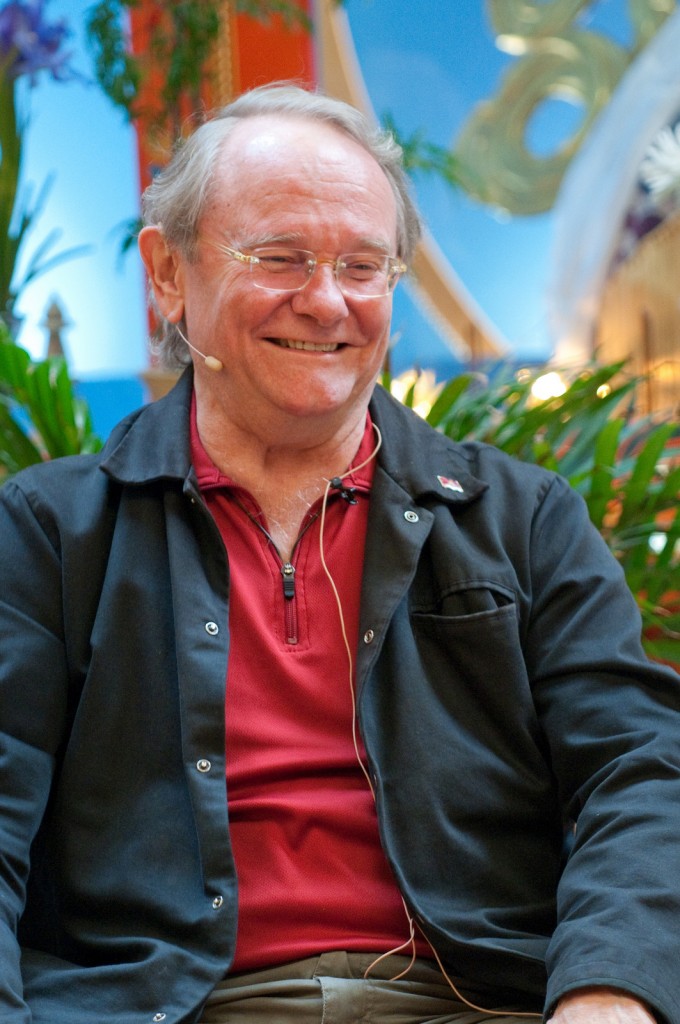
Dr. Jeffrey Hopkins, Maitripa College, Portland, Oregon, United States, September 2011. Photo by Marc Sakamoto.
Beloved Buddhist scholar Dr. Jeffrey Hopkins passed away on July 1, 2024 in Vancouver, Canada, aged 83.
Dr. Hopkins published dozens of books, acted as His Holiness the Dalai Lama’s translator, and had a long academic career during which he trained many prominent Tibetan Buddhist scholars and translators. He was remarkably open in public about a wide range of matters, such as his initial lack of faith in His Holiness, past-life memories, a near-death experience, his youthful delinquency, his sexuality, and so on. Dr. Hopkins was known for his frank and honest style of discussing all matters, even those considered controversial or taboo. He was also an FPMT Registered Teacher in the category “Senior Teachers of the Tibetan Buddhist Tradition.”
He was interviewed in 2014 by Mandala Publications, and we share that interview below.
Dr. Hopkins, what is the source of your frankness? Why are you so open?
I was born in 1940 in Barrington, Rhode Island, and I was in my teens in the 1950s. There was a group of us who were disgusted by the aims that were being presented to us: merely making money and so forth. There was a lot of rebellion that was focused against the dishonesty of society, which gradually in my own mind became a matter of seeking my own integrity. My own integrity meant a great deal to me.
I was part of a juvenile gang that got into difficulty with the law, in the sense of increasingly violent pranks, drinking and so forth. It was a relief when I went to a liberal prep school where students were given a great deal of responsibility for their own governance. Despite all my acting out at my public school, I responded very well in that kind of environment, and got excellent grades, because we were respected as people, which is something I had lacked prior to that. Then, in my first year at Harvard, I read Walden by Henry David Thoreau and I was inspired to leave Harvard for the woods of Vermont. I stayed in a small one-room cabin and read, wrote poetry, walked a lot, dreamt out my recurrent trapped dreams, and I believe at that point, began finding my own integrity. And I kept returning to that kind of life.
I was inspired by Herman Melville’s novel Typee, which is set in the Marquesas, north of Tahiti near the equator, and Somerset Maugham’s The Moon and Sixpence about the artist Paul Gauguin, who painted in the South Seas. It was 1960 and when Vermont got too cold for the wood heater, I went to the woods in Rhode Island. When that got too cold, I shipped out of New York as a passenger on a freighter to Tahiti. I had gotten used to meditating in Vermont on the lake that was down below, and by gazing off into space. On the freighter I would lie on my back and stare upward, filling my mind with the blueness of the sky. The Pacific Ocean was clean and tremendously calm and I filled my mind with that. I didn’t have a visa for Tahiti and after a while some official noticed this and asked me to leave. I used all but my last $15 to take a seaplane to Hawaii. It was nuts, but it was a search for my own integrity.
You were among the earliest scholars to show respect for Eastern scholars, and acknowledge what you learned from them, rather than claiming that you knew more than your “native informants.” Where did your intellectual honesty come from?
This was related to my attitude of searching. Why would I pretend that what l learned from a Tibetan scholar was something I put together myself? Why would I treat these people as somehow different from myself? I thought it was very important, extremely important, to treat every Tibetan scholar fairly, to give them credit for their part in producing any book. I was criticized for this by other professors in my own field. But it just made more sense to have, say, Lati Rinpoche, be a co-author, than to footnote everything he said. In time, people came to understand what collaboration meant. The old saying of “East is East and West is West” doesn’t carry over to how you treat people on the title page of a book.
By making clear what came from others, you revealed that the Western scholar wasn’t always the final expert. Did other academics criticize you for that?
Yes, they did, and I just chose to ignore it. I spoke recently at the Tsadra Translation & Transmission Conference about singing my own song, and what I meant is that certain priorities needed to be righted, and we would right them by how we acted and what we did. It means acknowledging the help you receive and the roles others play, and if those roles are prominent enough, then the person deserves equal billing as the author or the translator. If I couldn’t have understood the text without somebody informing me of its meaning, then that person has played an equal role in its translation even if they don’t know English, because I couldn’t have translated it otherwise. Not to mention the person’s contribution to the footnotes or the explanation that goes along with the translation. This approach has come to be generally accepted. And then also I wanted to point out that many of the academic concerns that Tibetan and Mongolian scholars have are similar to ours. Both sides can learn from the other, though I don’t like talking about sides. I think we are all more or less in the same soup.
Sometimes in Dharma centers people avoid sharing their real views or feelings. This helps maintain harmony, but at a price. It makes me wonder about the balance between building community and nourishing the individual.
I would compare it to when I started in academia. At that time, there was a lot of shouting among scholars. I thought it had a lot to do with how little we knew about the subjects we were talking about. And I had to admit that of myself also. I was so egregiously, embarrassingly ignorant on many of these topics. I could see how I could stumble into trying to cover up my ignorance by shouting or making a big fuss over something I knew that somebody else didn’t know. And then I tried very hard to avoid doing that, and to create an atmosphere in which I was not doing this. I think as this profession and its members have become more educated, there’s been less need to yell at each other, and this may be true in Dharma centers also. I’ve found in the two translation conferences I’ve been to, and many of these translators are members of Dharma communities, that we have no need at all to shout at each other or show off what we know because we are deeply impressed by what we don’t know. We are really happy to hear about these topics from our colleagues and friends who do know something about them. Then it’s easy to get along.
A community’s insistence on people toeing a line may have a lot to do with being neophytes. And the number of times that neophytes repeat the name of their organization or their lama really strikes me as a sign of weakness. Let’s just stop doing that. Still, within the monastic community, there are rules. Outside of the community, you don’t say nasty things about the community, because that disrupts the image of the community, and spreads gossip and so forth. But that implies that there can be criticism within the community. You’ve got to air differences and so forth. You should. But you can’t be arguing all the time, or sharing everything you think. Nevertheless, a healthy community has to have some way of airing what’s going on. You can’t be covering up all the time because it will explode, and the disharmony that will result from that is not going to be helpful.
On a personal level, I try to make the chance of hypocrisy less by admitting in public some of the things that I’m up to. For example, I gave a talk in a city recently and I was really surprised when the people there gave me some money, in envelopes, afterwards. But then also, at the same time, I was very greedy about that money. I kept wondering how much was in each envelope. And I was very careful to put those envelopes down beside me (laughs) so that nobody would walk off with any of them. And I mentioned it to my host afterwards, admitting how greedy I was about it. I try to make this a habit. I don’t make up stuff to disclose, because there’s plenty of it without making anything up. I may not disclose everything, but at least a whole lot of it. Disclosing it relieves tension, whereas hiding is really counter-productive, because when you hide, you have to simulate the opposite – and, wow, you just get into trouble. I get into trouble!
Is this an aspect of the path? Does not being open reduce energy available for practice?
I think that’s very, very true. Energy is wasted by hiding, and what you are hiding gets worse and worse the more you hide it. It’s self-destructive. You know, sometimes when I talk about morality, I’ll just say, “I’m embarrassed about what I am saying, but in any case, I’m trying to present what the books teach as it’s written, and I’m not claiming that I can actually enact this, I want to be clear.” That makes it a lot easier to talk about it. If it’s compassion and the fact that I get angry in certain situations, then it’s easy for me to talk about what I get angry at and use that as an example. Being frank about myself undermines my own negative reactions.
But we have to be judicious about what we say. We can’t be stupidly open. It’s not easy.
Buddhadharma focused its Winter 2014 issue on abuses of power in Dharma communities. One theme was “no more secrets,” because abuses flourish when people deny, cover up, or ostracize those who speak out. What are your thoughts on this?
I’m not an active member of any group. I’m a member of groups, but from a distance, which gives me a certain safety valve. I don’t give any quarter to lamas and so forth who act contrary to moral codes. To me that’s simply improper. If I’m asked about that person, I just say what I’ve heard, I don’t cover up, or at least I hope I don’t. I’m open about what I’ve heard and I’ll say, “Beware.” Covering up or pretending that seemingly ill behavior is the way great lamas behave – I’m just not going to say that. I think that’s simply wrong.
You have mentioned that your relationship with His Holiness the Dalai Lama is very frank. How open should we be with our lamas?
It depends on what the lama can stand! The lama may not want to hear about it. And then what can you do? You may have to go find some other lama, if that’s what you need. Like with anyone, your friends for example, there are certain subjects that some people don’t want to hear about. Even your closest friend may not want to hear about your stomach troubles. So you don’t talk about it. And how much can anyone stand to hear about your sex life? Or your health problems? Even if you’re at death’s door, five minutes is the max. It’s a bore. You shouldn’t expect more than that.
Westerners seem to value openness more than Tibetans. Is there a cultural difference?
I don’t think Tibetans are different from us. Maybe they are getting away with being secretive about how they are running things here (laughs). They are just getting away with pretending that this is the way that they do it. Tibetans among themselves give each other a hard time. They hold each other to account. Whereas some of them come over here and act as if they are kings or queens. They’ll do whatever they can get away with. You don’t have to let them.
Some Westerners, like you, say they have past life memories. While this may come from a desire to be special, there must be some who really were practitioners in the past. Should people be open about memories if they have them? What about the narcissism factor?
I was faced with this during the five years I was at Geshe Wangyal’s monastery in New Jersey in the early 1960s. People would come to visit and talk about their past lives. They were usually princes and princesses. I was looking forward to the day when someone would come and say they were a garbage collector. It’s something that kept me from telling my own story because I didn’t want to be put in the category that I was putting these people in, which has to do with their own aggrandizing imaginations. With myself, I felt what memories I had were rather ordinary. I had to inspect those few memories to figure out what my so-called status was. I didn’t feel glorious. I had to deduce from a few pieces of information what my status might have been. It took a long time for that to come through. I’m suspicious of people who remember themselves as having been very glorious.
Still, I stay neutral on whether people should talk about memories. Although I’m suspicious, I’m not going to put it down. I know in my case that these are actual memories, so I know that does occur. But I wouldn’t blame anyone for being highly suspicious if I told my own story in any detail. They might think, “The guy’s a nut!” I’ve had that kind of thought with respect to others. But some people have related their stories to me, and their memories are not self-glorifying. I don’t have any reason to question them. I do accept for sure that people remember.
Dr. Ian Stevenson of the University of Virginia looked into a lot of reincarnation stories, and checked some against facts he could track down. One of the points that he made was that quite a number of people remembered their past lives because they died in the midst of violence. It was quite often not a case of great spiritual attainment, but that there was some violence that impressed on them what was going on, and that caused the memory.
Canadian tulku Elijah Ary has been open since childhood about his past life memories and went through a lot of difficulties.
I know Elijah Ary. I find his story quite poignant. He and I had quite opposite trails. He has been open throughout and I’ve been closed throughout. I actually forgot it for quite a while and then even after I remembered, it was decades later that I was willing to talk about it at all except with a couple of people. It’s been quite a journey for him, and I really respect what he’s had to go through to be this open. He paid a huge price. For me, coming out as gay was a big step at the time I did it, but coming out as remembering your past life, as far as I’m concerned, is much larger than that.
What does it really tell us if someone has past life memories? Does that make them special now?
I think that Dr. Ian Stevenson’s story about people remembering because they died in the midst of violence indicates that it doesn’t automatically make you special. What will make you special is what you do in this lifetime. If you think about it, that is true of anybody, recognized or not.
Liushar Thupten Tharpa, who was the equivalent of foreign minister in the old government of Tibet, went out to greet His Holiness the Dalai Lama when he first came to Lhasa; Liushar told me he was watching the little child to see if this was the right one. But he didn’t come to any conclusion then whether this was the right or the wrong child. Later he was this Dalai Lama’s representative in New York, after which he came to our monastery in New Jersey, and then stayed on in the USA as a permanent resident. Then the Dalai Lama called him back to Dharamsala. There were a number of years during which Liushar had not seen this Dalai Lama in action on the home front, although he had visited India for important events. Anyway, after he went back to India, I saw him. He said, “Do you know what he is doing?” and he recounted to me how busy this Dalai Lama was conducting ordination ceremonies, teaching, giving initiations, all of the many things he was doing. And he said, “Now we can say he is the incarnation of Avalokiteshvara.” You see? By way of his actions! That question about whether there were signs that he was the last Dalai Lama was totally wiped out. It didn’t matter. His Holiness’ actions were sufficient. Whether he was or not didn’t make any difference because in his waking day he was endlessly performing these actions.
While you are open about many things, you also choose to keep certain things private, such as your own attainments, and ways you’ve helped others – for example, with their books or academic work.
There’s a tradition about not being open about your own attainments and your own deeper experiences, and I don’t even tell my friends. It’s out of the question, I feel, that I’m going to talk about these things. As for helping others, it’s important to do – and keep quiet.
Any final thoughts on honesty?
If honesty became one’s only watchword, one could become a pain in the ass, and narcissistic, and a total bore. I hope by giving an interview like this, pretending to be honest, I don’t create a trap for myself! That I would become infatuated with this – really. And start deliberately acting this way, thinking, “I’ve got to be honest! I’ve got to find something to be honest about!” And turning myself into not just a 25- or 50-percent jerk but a 75- or 90-percent jerk (laughs). Warn me if I do. Tap me on the shoulder and say, “Hey Jeffrey, you are turning into a 100-percent jerk.”
We are basically incapable of saying who we are, and when we start doing that, we really have to be careful, because we aren’t going to be right. There may be some grain of truth – but also some grain of foppishness. I’m trying. I’m still trying to find my own integrity.
Previously published as an online feature of Mandala Publications, “Jeffrey Hopkins’ Transmission of Honesty,” an interview conducted by Donna Brown, January 2015.
You can listen to Dr. Hopkins in a lively conversation about his life with Wisdom publisher Daniel Aitken in the Wisdom podcast, “Jeffrey Hopkins: The Life of a Buddhist Scholar: wisdomexperience.org/wisdom-podcast/jeffrey-hopkins/
Please also see Tricycle magazine’s obituary of Dr. Hopkins: tricycle.org/article/jeffrey-hopkins-obituary
Please pray that Dr. Jeffrey Hopkins may never ever be reborn in the lower realms, may he be immediately born in a pure land where he can be enlightened or to receive a perfect human body, meet the Mahayana teachings and meet a perfectly qualified guru and by only pleasing the guru’s mind, achieve enlightenment as quickly as possible. More advice from Lama Zopa Rinpoche on death and dying is available, see Death and Dying: Practices and Resources (fpmt.org/death/).
To read more obituaries from the international FPMT mandala, and to find information on submission guidelines, please visit our new Obituaries page (fpmt.org/media/obituaries/).
- Tagged: jeffrey hopkins, obituaries, obituary
21
Welcome to our June 2024 E-News
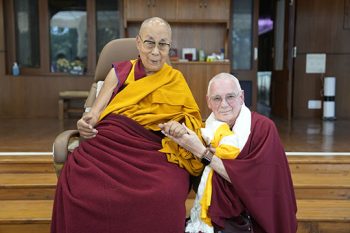
Ven. Roger Kunsang meeting with His Holiness the Dalai Lama, May 17, 2024. Photo courtesy of the Office of His Holiness the Dalai Lama.
This month’s e-news brings you important news, updates, and causes for rejoicing regarding:
- Nonstop prayers for Lama Zopa Rinpoche’s swift return
- Teachings from Lama Zopa Rinpoche and Lama Yeshe
- News about and advice from His Holiness the Dalai Lama
- Ongoing support to elderly Tibetans
- Recent anniversary pilgrimage to Lawudo
- Center and regional news
- Resources for your study and practice
- Opportunities and changes within the organization
and much more!
Please read this month’s e-news in its entirety.
Have the e-News translated into your native language by using our convenient translation facility located on the right-hand side of the page.
- Tagged: fpmt enews
18

Students with Charok Lama and Rinpoche’s sister Ani Samten in front of the Lawudo gompa.
Following the Heart Sutra Retreat at Kopan this year to mark the first anniversary of the passing of Lama Zopa Rinpoche, a group of 38 students from around the world participated in a special Lawudo Anniversary Pilgrimage from April 24-May 8, 2024 to visit and make heartfelt prayers at the holy places of the Lawudo Lamas—Rinpoche and his previous life as Lawudo Lama Kunsang Yeshe. Please read this beautiful account of the pilgrimage by Amitabha Buddhist Centre’s Ven. Gyalten Rabten.
Our journey started on a positive note as we were able to fly directly on two special flights from Kathmandu’s domestic airport to Lukla (9,383 feet, 2,845 meters). We landed safely at the small airport and started our trek soon after breakfast once our bags had been given to the porters to carry to our guest houses ready for us to pick up each evening.
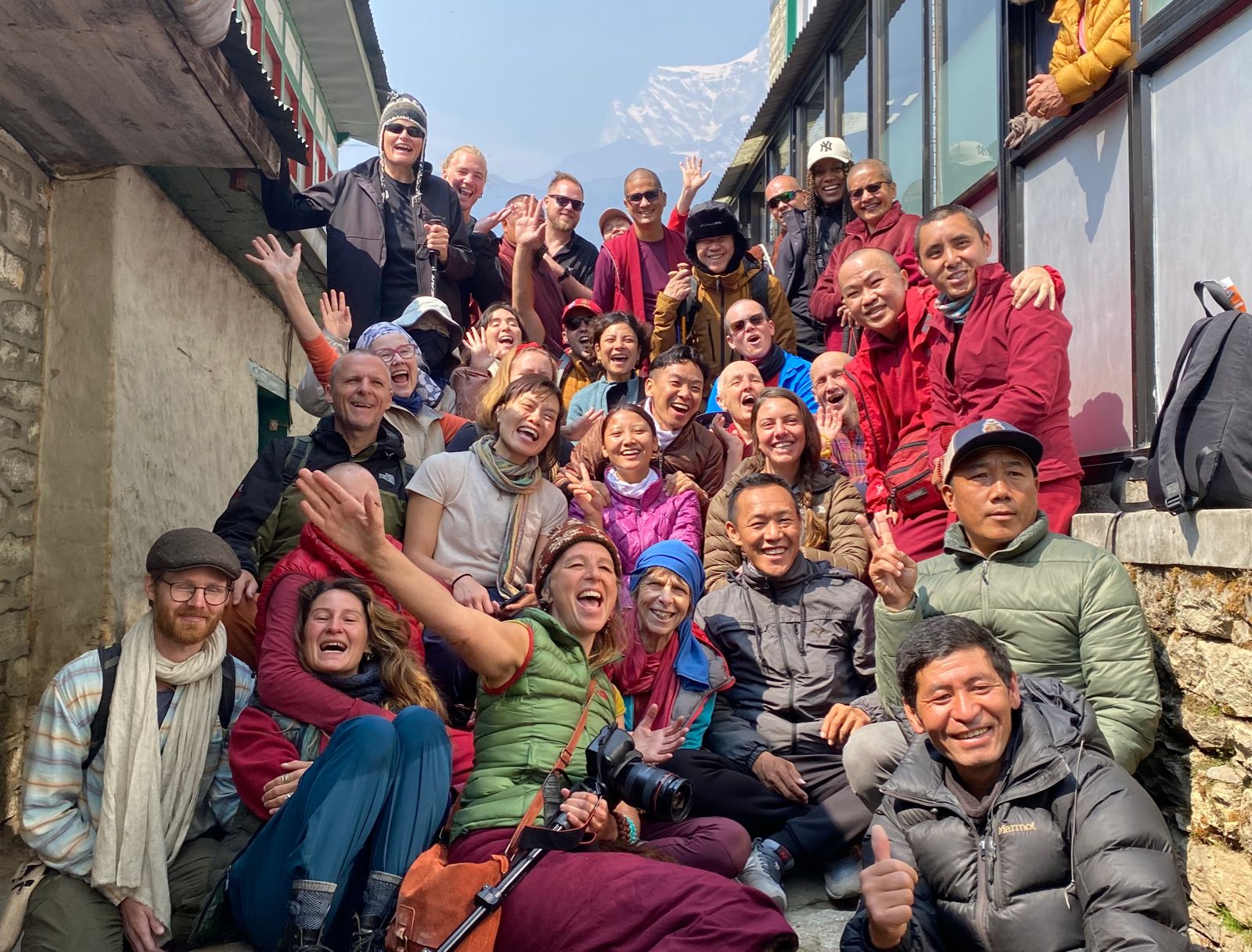
Group photo at Namche. Photo by Ven. Gyalten Rabten.
Over the next few days, we trekked daily for about six to seven hours, covering an average distance of nine to ten kilometers (5-6 miles)—sometimes more—mostly ascending. The first night we stayed over in a place called Benkar (2,800 meters, 9,186 feet), a place blessed by great meditators in the past, and for the next two nights we rested in Namche Bazar (3,440 meters, 11,286. feet), the largest town in Khumbu, for acclimatization. Some of us, myself included, found it particularly challenging as we had never walked so much in a day, but we were rewarded with breathtaking natural scenery along the way—the soaring high snow mountains, clear blue skies, flowing rivers, waterfalls and lots of beautiful rhododendron flowers. We were also mesmerized by the air of magical spirituality in Khumbu—dotted with many white stupas, stones carved with mantras, colorful prayers flags, and the occasional monasteries, temples and caves perched high up amongst the mountains.

The view from the hotel in Namche, April 27, 2024. Photo by Ven. Sarah Thresher.
On day four, we arrived at the high valley of Khumjung and Kunde above Namche, the spiritual heart of Khumbu. There we visited Khumjung Monastery, the second oldest monastery in Solukumbu, which Rinpoche had helped to rebuild after the 2015 earthquake. It is famous for its “Yeti scalp,” but we were there to learn more about the secrets of Khumbu as a “hidden valley” blessed by Guru Rinpoche from a local expert and guest speaker; and also to pay respect to the many sacred artworks and precious statues whose restoration Rinpoche had helped to sponsor, such as a Guru Rinpoche with a third eye, the only known statue of Khumbila, the local protector, and some exquisite wall paintings by local artists.

Descending into Khumjung on the way to Kunde below the sacred Kumbila mountain. April 27, 2024
The following day, those in the group who were more fit, made a challenging three-hour hike up to Akar Drubkang. At the height of 4,400 meters (14,436 feet), it is a special hermitage cave where Guru Rinpoche and Princess Mandarava are said to have flown from Maratika after accomplishing the practice of immortality. Many great masters in the past, including the Lawudo lama, have practiced and received teachings in this cave. Therefore, the group took the rare opportunity to make tsok offerings and recite heartfelt prayers for Rinpoche’s swift return in that blessed cave! Meanwhile, the rest of the group including myself, hiked up an hour to Hillary Viewpoint, where we were wowed by the stunning view of the surrounding snow mountain peaks, including the famous Mount Everest. We also managed to catch our first glimpse of Lawudo from that high vantage point!
On day six, we left Kunde and trekked onward through Thamo below Lawudo where Kari Rinpoche’s Nunnery is located for lunch and then on to Thame village, arriving in the late afternoon. This is where we can still see the small house where Rinpoche was born, newly rebuilt after it was damaged in the 2015 earthquake. Next to the house is a large prayer wheel containing 100 trillion Chenrezig mantras built by Rinpoche’s sister which is open 24 hours a day for people to turn and create merits. When we visited the house the next day to recite prayers for Rinpoche’s swift return, special arrangement was made for us to receive blessings from the Lawudo Lama’s precious lotus hat which as the first Lawudo Lama he had always worn.
We also visited the magnificent Thameteng Stupa, about half an hour’s trek from Thame. It was rebuilt in the style of the Boudanath stupa after the original stupa was heavily damaged in the 2015 earthquake and was consecrated by Rinpoche remotely in August 2022. There, we were briefed by the project manager, Thukten Sherpa, who at one point was moved almost to tears, as he described how from the very beginning the reconstruction was possible only due to Rinpoche’s kind guidance and financial support and also spoke of the many other beneficial activities of Rinpoche in this Thamichowa region.
Next on the itinerary was a visit to Thame Monastery, one of the three oldest in Khumbu, where had a nice lunch together with the young Thame Rinpoche and his monks. The Lawudo Lamas are closely connected with Thame Monastery and this was where Rinpoche first became a monk as a young boy. The manager showed us a set of cymbals gifted to the monastery by the first Lawudo Lama and blessed us with its beautiful sound when it was played. He explained that this special gift could be one reason for Rinpoche’s huge fame and renown throughout the world this lifetime, along with his ability to spread the Buddha’s teachings far and wide.
On day eight and after another four hours of ascending, we finally arrived at our main destination, the Lawudo Retreat Center at a height of 4,000 meters (13,123 feet)! Of the many precious places to visit at Lawudo, the main holy site must definitely be the Lawudo cave, where the first Lawudo Lama—Rinpoche’s previous life—had spent many years of his life in meditation and finally attained the highest realizations with many special signs when he passed away. Inside is an precious stupa with relics from the first Lawudo Lama Kunsang Yeshe and also a recent stupa brought up last year by Ven. Roger at Lhabab Duchen with a tooth relic from Rinpoche’s most recent life.

The newly built memorial stupa for Rinpoche in Lawudo. Photo by Ven. Gyalten Rabten.
The retreat center has several basic retreat rooms for students and visitors to stay or do retreats. The old gompa, the first and only one to be built under the supervision of Rinpoche (before Kopan even existed), now houses many amazingly beautiful statues such as the five-feet standing Sampa Lhundrupma Guru Rinpoche statue and a recently added Kalachakra statue.
For the last fifty over years, Lawudo has been being steadfastly cared for by Rinpoche’s elder sister, Anila Ngawang Samten. On May 3 which was a tsok day, we offered a guru puja and tsok in the Gompa and celebrated Anila’s 83rd birthday with many prayers and dedications for her long life and good health!
We spent the next four days in Lawudo, attending teachings on the Three Principal Aspects of the Path by Charok Lama Rinpoche, a young tulku recognized as the incarnation of the late Venerable Kushog Mende, who was a friend of the previous Lawudo Lama and spent many years practicing in a hermitage cave nearby. Many of us were moved to tears when he began the teachings by describing Rinpoche’s many and unfathomable qualities. During other times, we were divided into small groups to recite prayers for Rinpoche’s swift return inside the cave using a special practice compiled for the pilgrimage.

Students doing prayers in the Lawudo cave. Photo by Ven. Gyalten Rabten.
The evenings were spent in the warmest place in Lawudo, the dining hall where we gathered to hear stories from Ani Samten while hot drinks and delicious dinner such as garlic soup, momos, and potato pancakes were served. Those were truly unforgettable moments of family feeling and bonding for us all as we shared stories and experiences. After dinner, we once again recited prayers and practices for Rinpoche’s swift return all together before retiring, in order to dedicate all the virtue we had created throughout the day.
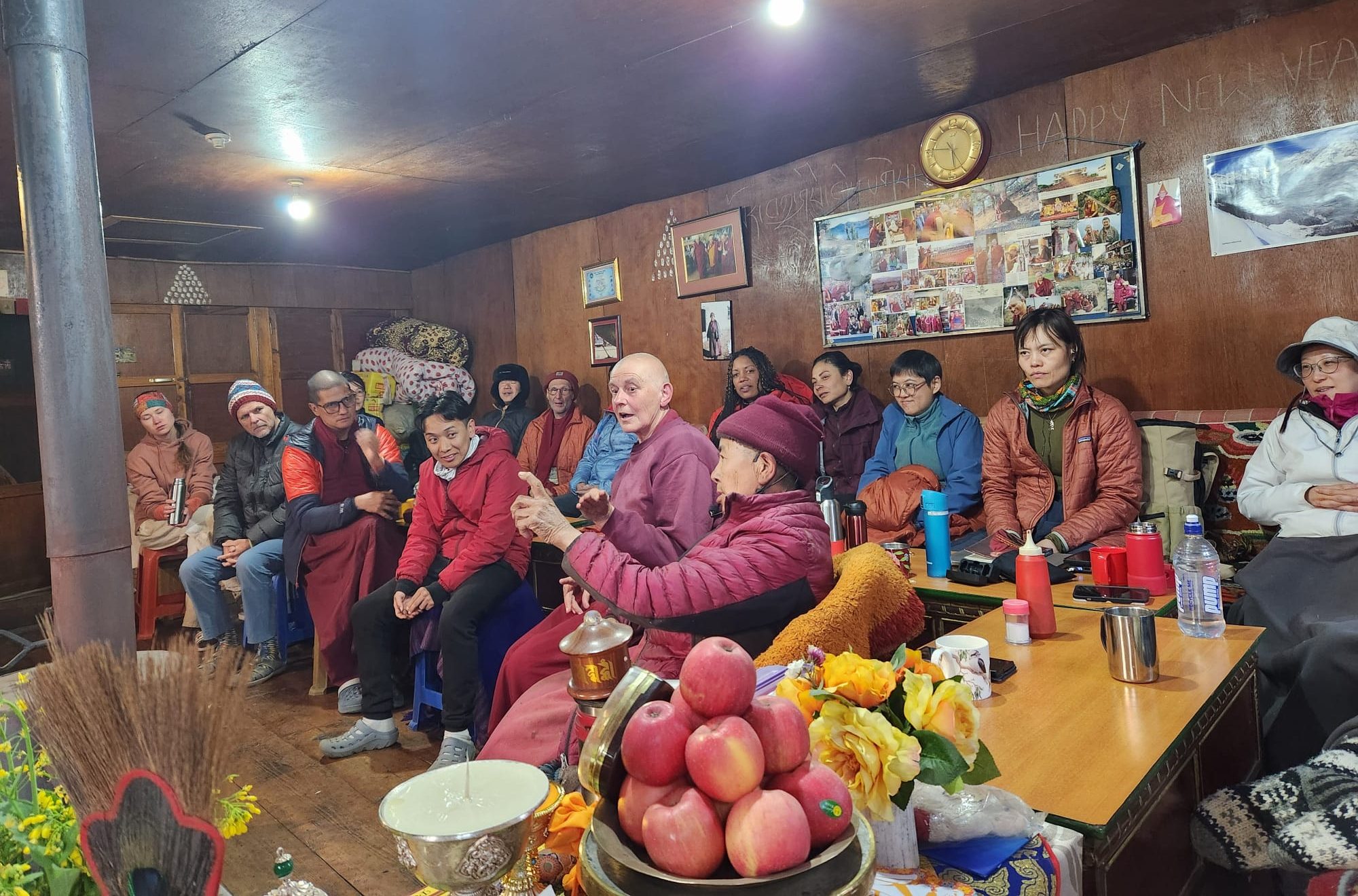
Ani Ngawang Samten recounting past stories of Rinpoche and Charok Lama in the dining hall. Photo by Ven. Gyalten Rabten.
Soon it was time for us to depart! After a trek of two days down from Lawudo, the group managed to take flights from Lukla back to Kathmundu during a window of clearer skies and weather before the fog crept in!
What a special lifetime experience and pilgrimage it has been for me and the group in honor of our most beloved guru! Many thanks to the organizers, including Charok Lama Rinpoche, Venerable Sarah Thresher, Venerable Nyima Tashi, Venerable Kalden and all those who helped and made it possible!
May the merit accumulated from this pilgrimage be dedicated for a new Lawudo Lama to swiftly reappear with all the qualities and attributes needed to guide us just as Rinpoche so lovingly cared for us his whole life and to continue the unimaginable blessings of his work spreading the pure Dharma teachings in all directions.
May the smile of a reincarnation swiftly beam in glory for fortunate disciples!
With grateful thanks to Ven. Gyalten Rabten for this inspiring report and to the pilgrimage participants for sharing photos with us.
To lean more about Lawudo, please visit: http://lawudo.com/
Foundation for the Preservation of Mahayana Tradition (FPMT), is a Tibetan Buddhist organization dedicated to the transmission of the Mahayana Buddhist tradition and values worldwide through teaching, meditation and community service.
- Tagged: lawudo, lawudo pilgrimage
17
The Answer Was Travel, Serious Travel
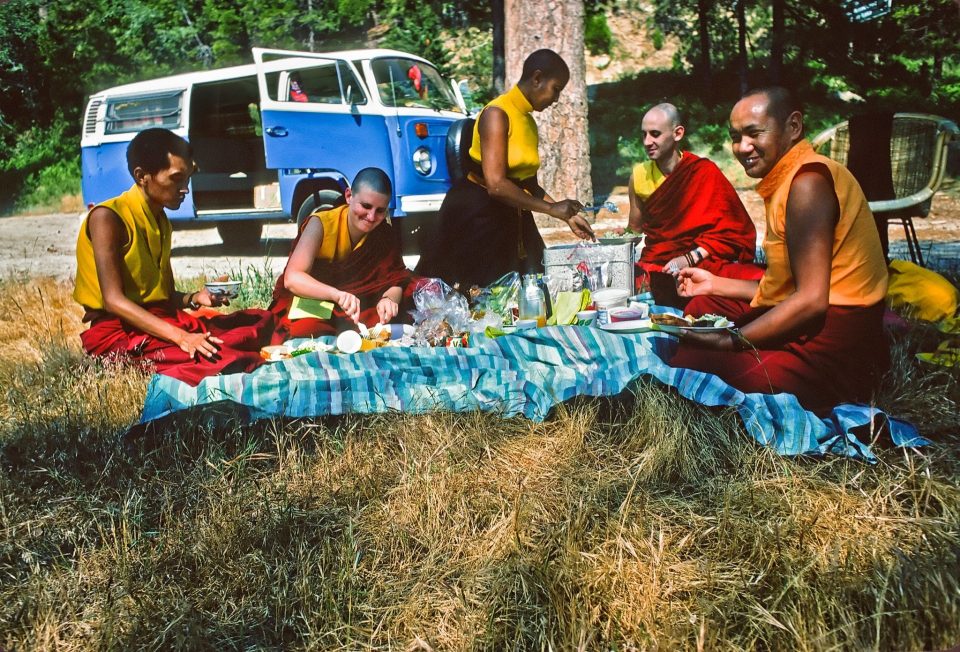
Picnic with the lamas. From left to right: Lama Zopa Rinpoche, Thubten Wongmo (Feather Meston), Max Mathews, Nick Ribush, and Lama Yeshe. This photo is from a three week retreat the lamas taught at Camp Arrowpines on Lake Arrowhead, east of Los Angeles, USA, 1975. Photo by Carol Royce-Wilder.
Dr. Nick Ribush was practicing medicine in Australia when, for various reasons, he got a bit disillusioned with it and, in May 1972, set off to travel the world. By the end of the year he was living at Kopan, beginning what is, at this point, a five-decade career in the FPMT. “If at the time someone had told me what would happen to my life if I did that course,” he says, “I probably would not have done it!” Since then, he has, on behalf of Lama Yeshe and Lama Zopa Rinpoche, founded and directed Wisdom Publications, Tushita Mahayana Meditation Centre, Kurukulla Center and the Lama Yeshe Wisdom Archive, which he has run for the past twenty-five years. He told Mandala what led him to the Dharma.
- Tagged: road to kopan
10
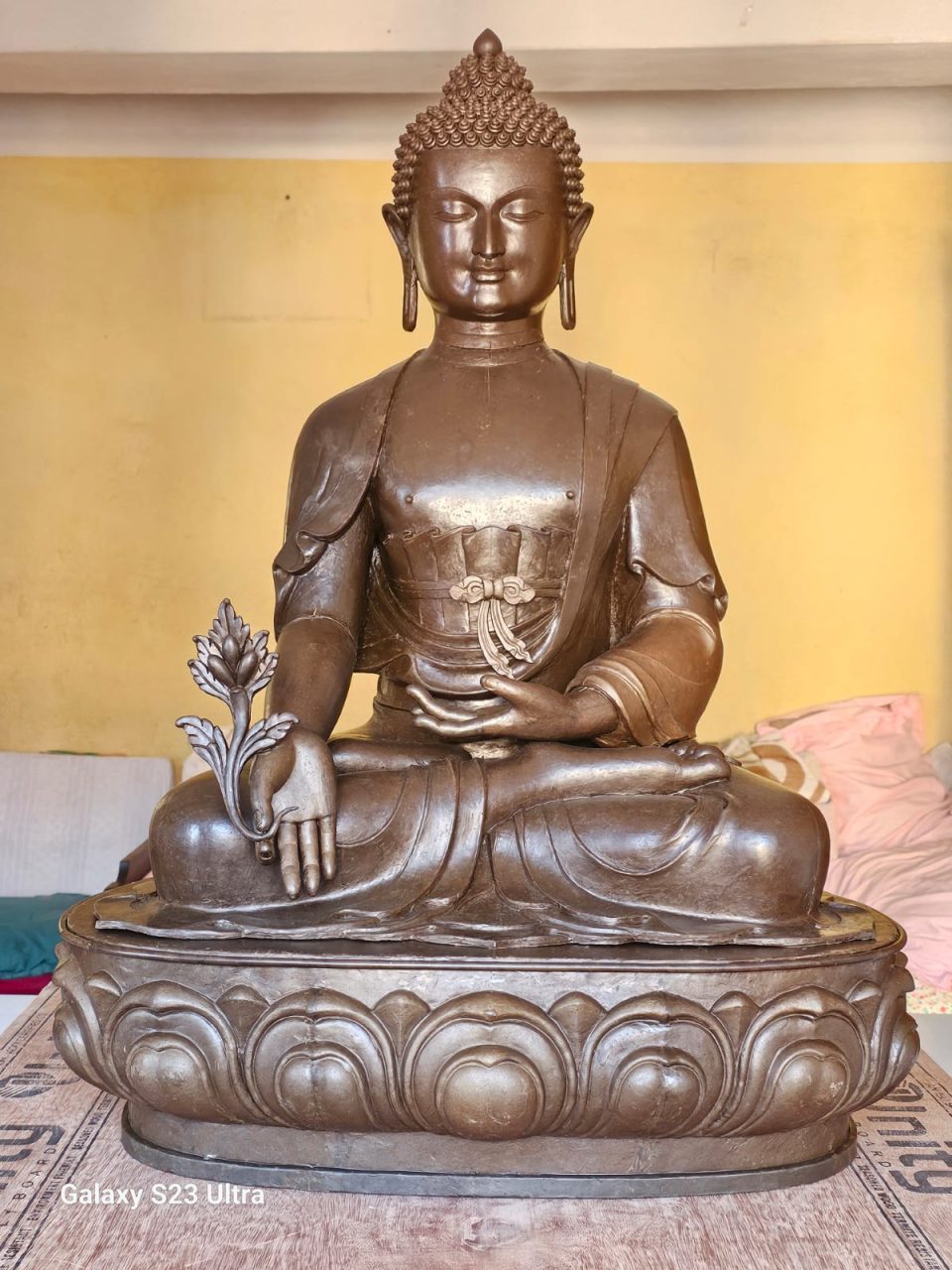
Wax Medicine Buddha prototype being built according to Lama Zopa Rinpoche’s instructions. Photo by Frank Brock
In September 2024, Sri Lankan-born, Australian-based nun Ven. Tenzin Lekdron will lead a pilgrimage tour in Sri Lanka to raise funds for the 5MB Project, a mission to build a five-story high Medicine Buddha statue in Sri Lanka, according to the instructions of Lama Zopa Rinpoche.
In 2021, Rinpoche determined the need for a large statue of Medicine Buddha to bring healing and harmony to Sri Lanka and its people, and gave Ven. Lekdron the task to accomplish it. Rinpoche specified that the statue should be five stories (16.5 meters) high, with, “proper proportions and excellent art for the face.” The statue will be filled, according to the Tibetan tradition, with rolls of mantras, sacred texts, and relics from high lamas. For the construction project to be successful, Rinpoche advised Ven. Lekdron to organize recitations of the Arya Sanghata Sutra and Sutra of Golden Light in Sri Lanka.
Ven. Tenzin Lekdron met Lama Zopa Rinpoche in 1998. After her ordination in 2016, she founded Tara Lanka Study Group in Sri Lanka and initiated dialogues, social services projects, translations of Mahayana sutras and Dharma texts into Singhalese, and organized group recitations of sutras by local monks and lay people around the country to create harmony and understanding between Theradava and Mahayana traditions in Sri Lanka. “From my first conversation with Rinpoche,” Ven. Lekdron reflects, “I came away with the clear impression that Rinpoche had plans for Sri Lanka and me.”
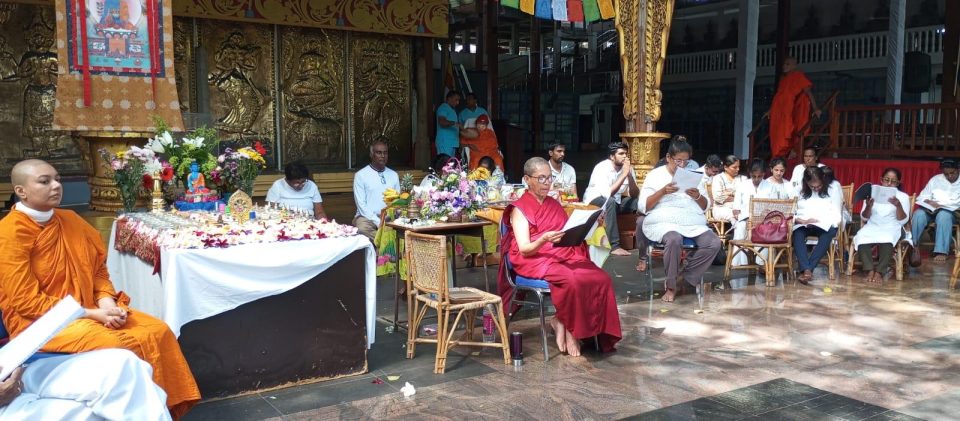
Extensive Medicine Buddha puja in Sinhalese at Gangarama temple, Colombo, Sri Lanka, attended by over seventy local people.
Sri Lanka embraced Buddhism from India in the 3rd century BCE. A branch of the bodhi tree, under which the Shakyamuni Buddha attained enlightenment, was brought to Sri Lanka by a nun named Sanghamitta and planted in the then capital, Anuradhapura. To this day the bodhi tree remains one of the most important sites of Buddhist pilgrimage. According to Ven. Lekdron, Medicine Buddha practices have had a shadow presence in Sri Lanka where indigenous medicine practitioners continue to recite the mantra without having any understanding of its origins.
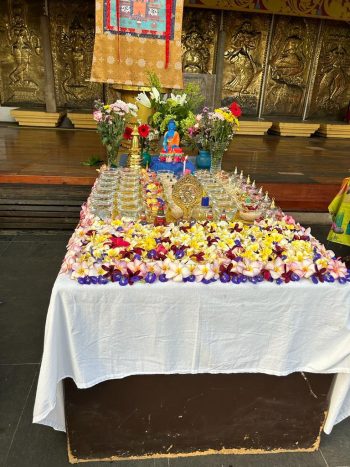
Offerings to Medicine Buddha arranged at Gangarama Temple. Photo by Malintha Perera
“I am convinced Rinpoche gave me this huge project because he knew there was an ancient connection to Medicine Buddha and strong Mahayana history in Sri Lanka,” Ven. Lekdron shares. “Medicine Buddha practices can heal the island’s damage. I have since found out that the Medicine Buddha mantra is still alive in indigenous medicine and there is still a pulse for non-sectarian dharma, one that we can hopefully strengthen.”
In 2020 the Sri Lankan economy collapsed, exposing widespread corruption and dysfunction and having tragic impact on the Sri Lankan people. Concerned about the future of Sri Lankan people, Ven. Lekdron sought Rinpoche’s advice on practices that would help the country overcome difficult times. Rinpoche advised to recite the Sutra of Golden Light and other Mahayana sutras and to build a five story tall Medicine Buddha statue. In early 2022, Rinpoche further advised to do extensive Medicine Buddha puja on auspicious days.
To create causes for the construction of the five-story Medicine Buddha statue, Rinpoche instructed Ven. Lekdron to order a scale prototype of the statue in Nepal. This 1.5 meter tall prototype will be made exactly to scale and fully finished with real gold. Expected to be shipped to Sri Lanka at the end of 2024, it will eventually be housed in a prominent Theravada temple in Colombo, the capital of Sri Lanka, becoming the focus of Medicine Buddha pujas and practices for the whole country.
To find out more about the pilgrimage tour, or for more information on how you can help the 5MB Project, visit: 5mbsrilanka.org
To learn about the Study Group in Sri Lanka, Tara Lanka: taralanka.org
Please learn more about Lama Zopa Rinpoche’s Vast Visions for the FPMT organization to have hundreds of thousands of holy objects around the world: fpmt.org/fpmt/vast-vision/#hobjects
6

His Eminence Ling Rinpoche teaching at Kadampa Center, North Carolina, US, May 8, 2024. Photo courtesy of Kadampa Center.
His Eminence Ling Rinpoche is currently engaged in a nine week teaching tour during April-June in the United States, visiting at least 28 different venues in a dozen states. The venues include Dharma centers and monastery gompas, and when those halls aren’t large enough: specially-erected teaching tents, Tibetan association halls, local community centers, churches, schools, universities, concert halls, and hotel conference rooms.
Among the various organizers are nine FPMT centers: Shantideva Center, Kurukulla Center, Guhyasamaja Center, Kadampa Center, Land of Medicine Buddha, Ocean of Compassion Buddhist Center, Tse Chen Ling, Vajrapani Institute, and Maitripa College (upcoming June 8!). We offer grateful thanks to Melissa Kaye, Regional Coordinator for FPMT North America, who attended the first four weeks of the tour (NYC through WI), for providing much of the information and quotes included in this report.
His Eminence made some incredibly moving remarks about Lama Zopa Rinpoche during these teachings, including how to pray for Rinpoche’s swift return, which we share below.
Many Tibetans were in attendance at several of these venues, including Tibetan dignitaries, and were the majority of attendees at Kurukulla Center, Massachusetts (April 21-22), even on the non-initiation days. On May 18, thousands of Tibetan people in Minnesota attended Buddha Amitayus initiation and teachings, organized by the Tibetan Foundation of Minnesota and Trehor Kyiduk Minnesota.
FPMT students from as far away as Latin America flew in for the teachings in NYC.
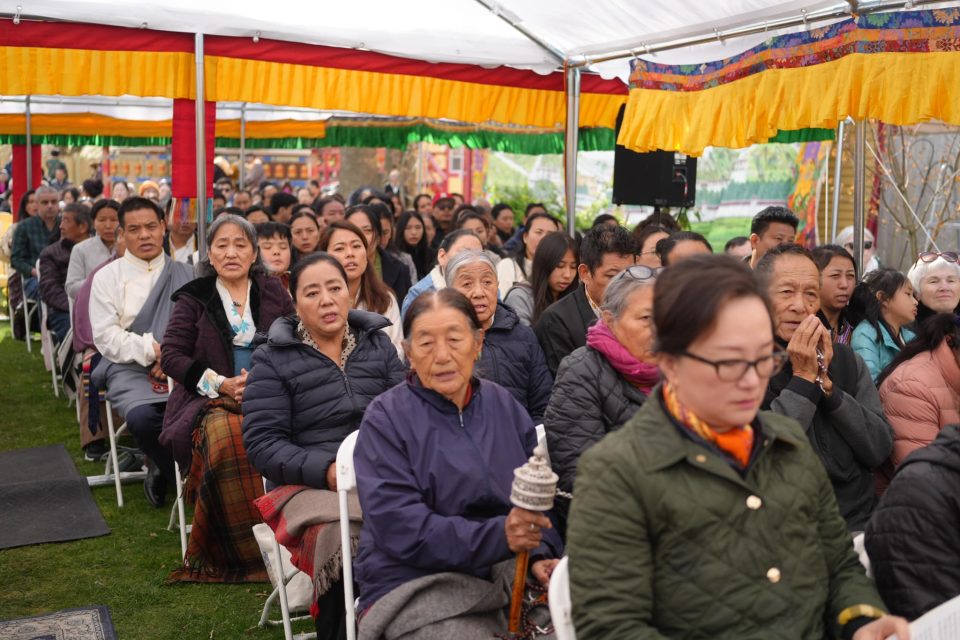
Members of the Tibetan community attending public talk with His Eminence Ling Rinpoche at Kurukulla Center, Massachusetts, April 22, 2024. Photo courtesy of the Kurukulla Center Facebook page.
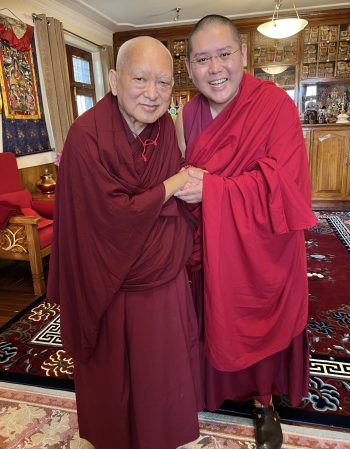
Lama Zopa Rinpoche with His Eminence Ling Rinpoche, India, 2022. Photo by Ven. Roger Kunsang.
His Eminence began his US tour at Shantideva Center, NYC on April 12, and his earliest remarks were about Lama Zopa Rinpoche’s passing:
“It was very painful to lose Rinpoche. … It really shocked me, really hurt, very difficult to accept. … Rinpoche was much needed in this world.
“Losing him was a big loss for every one of us. Although Rinpoche’s not with us physically, his legacy remains. It is very important that the followers should fulfill all his wishes, most importantly to follow his instructions, all the instructions that he has given throughout his life.
“More than, I would say, 50, 60 years, he’s been teaching all over the world, and Rinpoche was there for others all the time 24/7. He did not do anything, almost nothing, for himself, but always there for others. His love, his compassion, his teachings and his instructions have benefited countless beings.
“I think, most important is to practice well and this is the only way to fulfill his wishes. If we practice well, if we become a good human being and a good practitioner, this is the only way to fulfill his wish. This is something that Rinpoche wants us to do. Nothing else can fulfill his wish. Even if we offer the entire world to him, this will not fulfill his wish. So the only way to fulfill his wish is to become a good human being and practice the Dharma according to the teachings.”
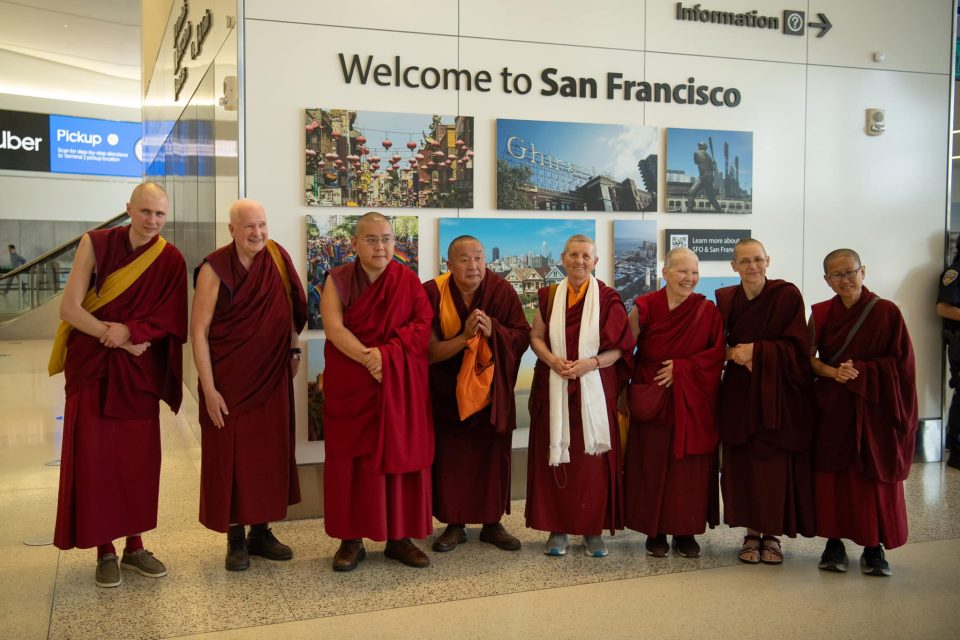
FPMT Sangha greeting His Eminence Ling Rinpoche at the SFO Airport, May 23, 2024. Photo courtesy of Land of Medicine Buddha Facebook page.
Melissa Kaye, FPMT North America Regional Coordinator shared:
“Rinpoche’s teachings at the FPMT centers focused on brief lamrim texts by Lama Tsong Khapa, bodhichitta topics (bodhisattva vows, lojong, and Atisha’s Bodhisattva’s Garland of Jewels), and some initiations. His Eminence began each teaching with a detailed explanation of the importance of setting a positive Mahayana motivation and concluded each teaching with extensive dedication prayers.
“His teachings flowed beautifully, in a traditional style, were extremely clear and organized, concise and to the point; scholarly while still relatable and applicable to modern daily life. Over and over again he reminded me of listening to His Holiness the Dalai Lama when His Holiness is giving traditional teachings to a mostly Tibetan audience in India. During the initiations, His Eminence carefully explained each of the steps and visualizations to be done so that we students could participate to the fullest of our abilities.”
From May 25-26, HIs Eminence gave teachings on The Foundation of All Good Qualities and conferred the 1,000-Armed Chenrezig Initiation, in the San Francisco Bay Area, California, jointly hosted by four local FPMT centers: Land of Medicine Buddha, Ocean of Compassion Buddhist Center, Tse Chen Ling, and Vajrapani Institute.
While in the Bay Area offering teachings, His Eminence also took the time to consecrate two holy objects:
On May 31, he consecrated the 3 quadrillion mantras filled compassion prayer wheel at Vajrapani Institute.
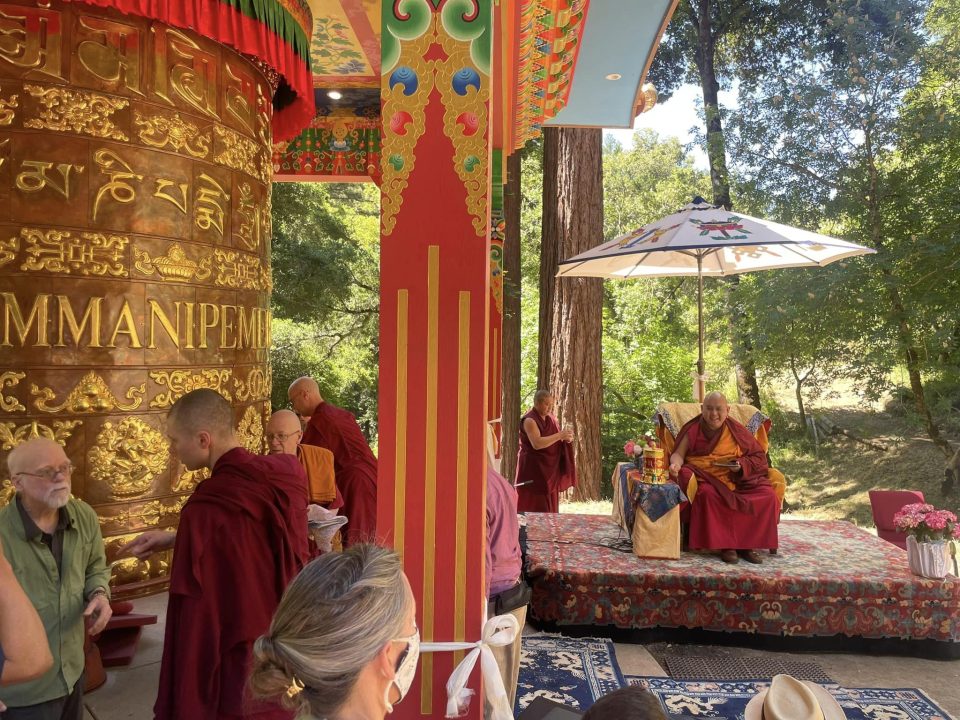
His Eminence Ling Rinpoche consecrating the 3 quadrillion mantras filled prayer wheel at Vajrapani Institute, May 31, 2024. Photo courtesy of Scott Snibbe.
On June 4 His Eminence was able to consecrate the stupa at Land of Medicine Buddha. LMB shared on their Facebook page: “Rinpoche remarked after finishing the consecration that he ‘didn’t want to leave.’ How our hearts were warmed by his loving presence and gentle guidance.”
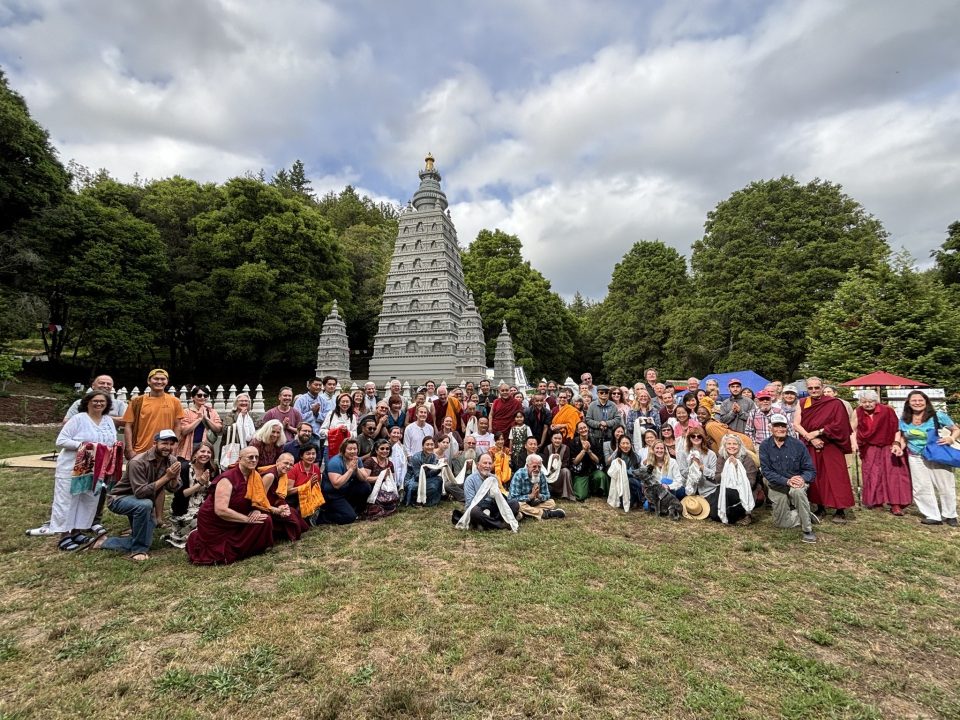
His Eminence Ling Rinpoche with the Land of Medicine Buddha community, after consecrating the stupa at LMB, CA, June 4, 2024. Photo courtesy of 100,000 Stupa Project at Land of Medicine Buddha Facebook page.
In the final dedication prayers at Kadampa Center, North Carolina, on May 8, His Eminence said:
“I pray for the swift return of the late Kyabje Lama Zopa Rinpoche, who was a great teacher. Most importantly, he was a great human being. That’s most important. He worked so hard for the benefit of other sentient beings. All throughout his life he worked for others. This is a very great role model.
“May there be the swift return of his new incarnation, someone who can fill his shoes, who can carry on the good job and who will be able to continue to carry on the legacy for the benefit of all sentient beings, particularly his Dharma students. But also—a very bright one is very important. If not very bright, then cannot do much, right? So a young and bright one, this kind of aspiration. We must pray from now, that bright, young and healthy one should come. Because once the child is born, we cannot change much, right? So the students need to pray from now. That is very important. I also pray for his swift return, a bright one who can work for others, who can really fill the shoes of late Rinpoche.”
Upcoming: His Eminence will offer a teaching on The Three Principal Aspects of the Path at Maitripa College in Portland, OR, on June 8 from 6:00 p.m. – 8:00 p.m. Those interested can join both in-person and online via Zoom.
You can learn more about His Eminence Ling Rinpoche, his tour in the US, and upcoming teaching tours:
www.lingrinpoche.info
Foundation for the Preservation of Mahayana Tradition (FPMT), is a Tibetan Buddhist organization dedicated to the transmission of the Mahayana Buddhist tradition and values worldwide through teaching, meditation and community service.
4
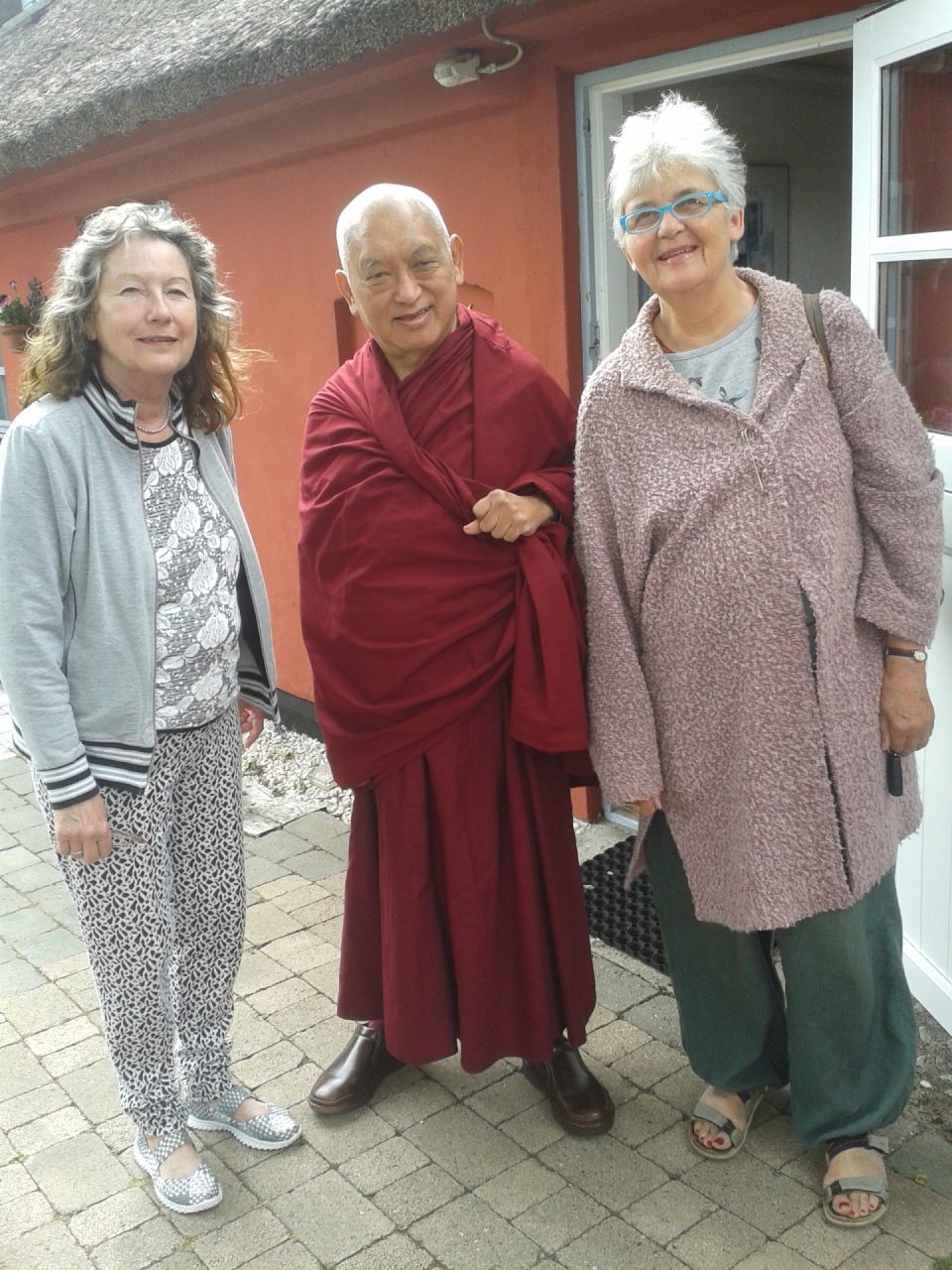
Lise Lotte, Lama Zopa Rinpoche and Maria Damsholt.. Photo thanks to CVM and Maria Damsholt.
Lise Lotte Brooks passed away of ALS on May 29, 2024 at age 77 in Denmark.
Lise Lotte founded Center for Wisdom and Compassion (CVM) in 1996 with Maria Damsholt. Here we share her obituary, which is also the story of CVM, written by Maria Damsholt:
Lise Lotte was born in Copenhagen 1946 of Danish parents. Around 1970 her parents got a divorce and Lotte chose to stay with the father, so he should not feel abandoned. It shows her kind mind. But not long after she went to Nepal to visit her old friend Åge Delbanco in Kathmandu. There she met her first husband, Chotak, and of course Lama Yeshe and Lama Zopa Rinpoche. She soon took Buddhist refuge there.
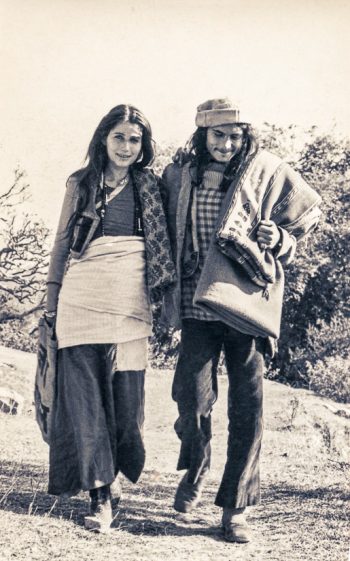
Lise Lotte and Chotak. Photo by Åge Dlebanco courtesy of LYWA.
Later her husband became a monk, and Lama Yeshe invited Lotte to live at Kopan Monastery with their two sons Thor and Jon. The little family built a nice little house up there which remained at Kopan for many years. Lotte took care of the children, and Chotak (the father) was able to go there and say hello.
Later her husband disrobed but was pursuing relationships with other women. I remember Lotte told me that Lama Yeshe told her to take her two children, move on in her life, and be proud and trusting in her own abilities. Lama Yeshe supported Lotte very much.
At some point Lotte moved to Sweden to a collective with the two children. They also lived at Vajrapani Institute in California, and at the new FPMT center Manjushri Institute on the countryside in England. She also moved to Hong Kong and made a business of making clothes and selling them. She made very good friends everywhere. She was so very good at connecting with people.
Around the time I met Lotte, toward the beginning of the 1990s, she started the company Silk Bliss, where she designed the clothes, and had them made in Hong Kong or elsewhere in China.
I myself took refuge with Lama Zopa Rinpoche in Holland at Maitreya Institute in 1990 and went to a long retreat in Dharamsala, where I had the luck and good fortune to meet Lama Zopa Rinpoche in an audience while the reincarnation of Lama Yeshe, Lama Osel, was a kid playing around there at Tushita Retreat Centre in Dharamsala.
Rinpoche encouraged me to translate some Dharma books and to go ahead with a project taking care of people who were dying. He gave us the three principles we still work from within that project, and somehow planted the idea in me that we should have a Danish FPMT center. Coming back home I really wondered how to do that, since all the Buddhists I met was connected to other lamas. But I prayed for it to happen.
I met Lotte through Kari Cuelenaere, whom I met in Kathmandu the year before I took refuge. At the time when I met Lotte, she had moved back to Denmark and lived in Ballonparken on Amager. Since she also knew Kari and she wanted to bring some goods to Kari, I managed to go out there and meet Lotte. One day I asked Lotte, if we should start a FPMT center in Denmark and lo and behold, she said yes. Luckily at that time I lived in a big house in Emdrup so we had our first gompa there. Among others Lakha Lama joined us in opening the new center.
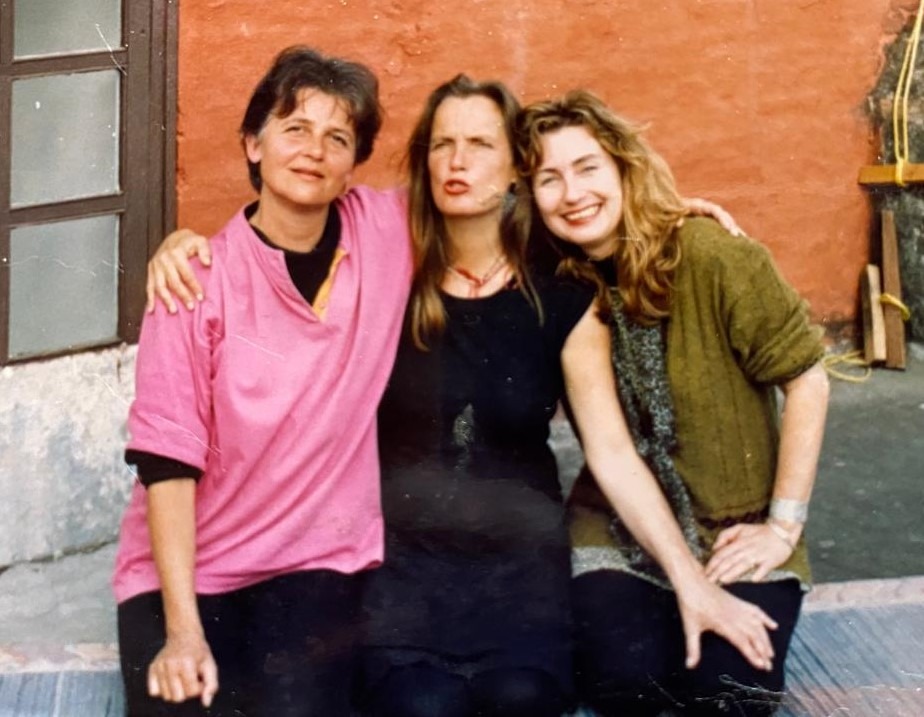
Maria, Kari Cuelenaere and Lise Lotte in the beginning of the 1990s. Photo courtesy of Maria Damsholt.
In the autumn 1997 we were called to the grand opening of the Jamyang Centre in London. Rinpoche gave us the name Tong-nyi Nying-je Ling, Center for Wisdom and Compassion (CVM). Lotte was to be the director and I was to be the coordinator of the death and dying project which at that time I called, Center for Conscious Living & Dying (later we got the name Pure Land of Medicine Buddha), and Rinpoche said it was most important to teach and be aware of the Buddhist way of helping people when they die.
While we stayed in Emdrup, Rinpoche came and blessed the center around 2000. Rinpoche gave Tara initiation and Medicine Buddha initiation. Lotte managed to get all the beautiful pictures of Lama Tsong Khapa and framed them in frames painted with gold. Lotte also managed to get carpets in our gompa and made a lot of very nice dark red cushions. She was able to sew very, very nice things and she always looked so beautiful too. She was very efficient. After Rinpoche left, we were almost drunk from pure happiness. We could not stop laughing.
After some years Lotte managed to find a place in Copenhagen, Klerkegade, where we rented a business flat. Lotte made a big curtain to draw for the altar so we could use the place for courses and supervisions for Center for Conscious Living and Dying.
Other dedicated Dharma students became involved in CVM and Tine Norup and I went to Vajrayogini Institute for a course with Rinpoche to ask if we should move in the place where Phendeling Buddhist Center was establishing itself, or find a place for us alone, since Klerkegade was too expensive for us.
According to Rinpoche it was even better to move into Phendeling’s big place. And since the death and dying project was able to get funds, we had furniture, printing machine, sound equipment, etc. and we could pay for the office.
In 2015 Rinpoche came again and gave Medicine Buddha initiation. We had a picnic at Nykøbing Sjælland where Rinpoche gave a teaching on how to bless the food among other things and held a meeting for the Nordic and Baltic FPMT centers and projects. Rinpoche and his entourage stayed at Lotusgaard, where Lotte had lived for some years with her husband Glenn and where they had a bed and breakfast.
At that time Lotte was no longer director of the center but she was very involved in translating Dharma books into Danish through the publishing service Forlaget Dharma Visdom. Lotte has translated the books Lamrim Outlines by Karin Walham and How to Meditate by Sangye Khadro into Danish. Sangye Khadro was going to be our residential teacher, but it became too expensive for us, so we had to move out of Nybrogade, which was such a beautiful place, and since then CVM has mostly had its physical events at Phendeling.
Lotte was a very, very kind and loving person. She was an excellent center director, good at connecting with people. She had a very tender mind, but she also could be very firm. She had to be firm with me sometimes. For that I respected her very much.
She was beautiful outside and inside. I will miss her for her peaceful, calm, and tender mind. And for all the laughter we had together in many situations. I was the first person outside the family she told about her sickness which was a special gift of trust from her side I appreciate very much.
Written by Maria Damsholt, co-founder of CVM and coordinator of Pure Land of Medicine Buddha. Edited for inclusion on fpmt.org.
Please pray that Lise Lotte may never ever be reborn in the lower realms, may she be immediately born in a pure land where she can be enlightened or to receive a perfect human body, meet the Mahayana teachings and meet a perfectly qualified guru and by only pleasing the guru’s mind, achieve enlightenment as quickly as possible.
More advice from Lama Zopa Rinpoche on death and dying is available, see Death and Dying: Practices and Resources (fpmt.org/death/).
To read more obituaries from the international FPMT mandala, and to find information on submission guidelines, please visit our new Obituaries page (fpmt.org/media/obituaries/).
- Tagged: lise lotte, obituaries, obituary
31
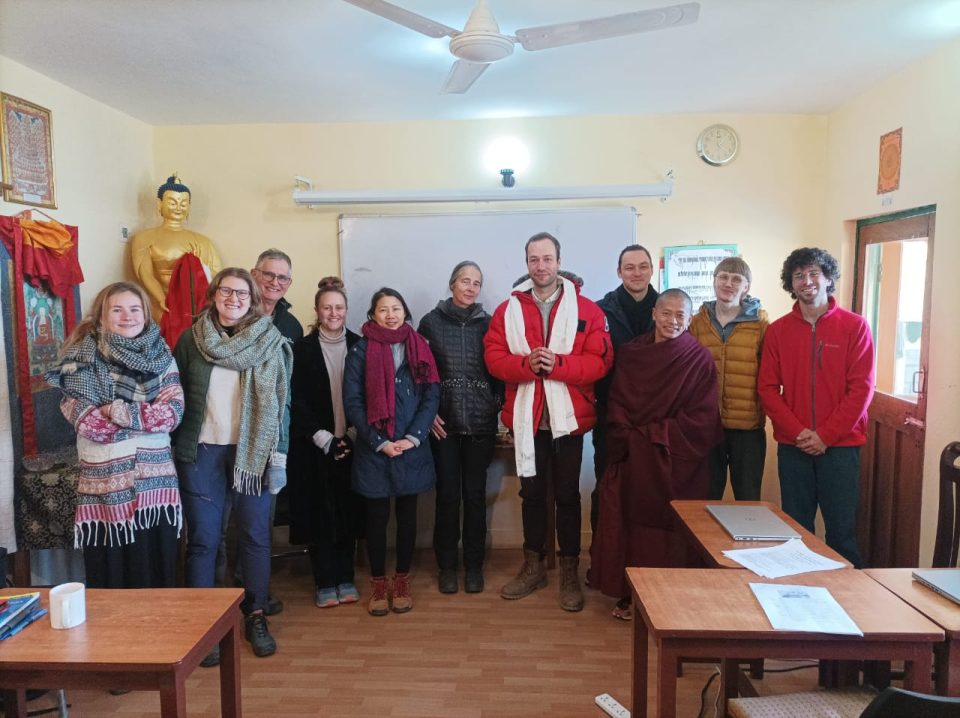
Lotsawa Rinchen Zangpo Translator Program participants.
Lotsawa Rinchen Zangpo Translator Program (LRZTP) is an FPMT project in Dharamsala, Himachal Pradesh, India. LRZTP has produced many gifted Dharma interpreters-translators for FPMT Dharma centers since its conception over twenty-three years ago. In addition to the two-year intensive training program, LRZTP also runs short Tibetan language courses and offers private online Tibetan language lessons.
The latest interpreters training course, LRZTP9, successfully began in April 2023, with twelve new students. At the completion of their first year of the two-year program, we are happy to share this report from LRZTP on the progress of the students:
For the Lotsawa Rinchen Zangpo Translator Program students of the ninth edition it all began on April 24, 2023. Their journey through the mountains and valleys of Tibetan grammar has been an adventurous one. But they have made it! The whole group graduated with wonderful results on April 19, 2024 and had their well deserved holiday.
And then on May 6 they began their second and final year of LRZTP9. The new journey is quite different compared to the first year. The focus in year one was the language. Students learned loads of vocabulary as well as intricacies of Tibetan grammar (both colloquial and literary). They passed tests and checked themselves every day during conversation classes.
The new journey brings new adventures. In the second year the focus is on Dharma in Tibetan. English is no longer there to help understand and explain. Now everything is in Tibetan. And the teachers of the program are now our wonderful geshes who will lead the students through such topics as the Lamrim (Stages of the Path), Dura (Collected Topics) or The Thirty-Seven Practices of a Bodhisattva.
This of course brings new challenges. That is why every afternoon the students will still learn one on one with their conversation tutors to help clarify difficult points. The core of the geshes’ team to guide students through the second year is: Geshe Lhundup Kalsang, Geshe Phuntsok Legmon, Geshe Tsering Samten, and Geshe Tsering Dargye. All of them have the highest qualifications to teach these topics.
Very soon the students will begin their debate practice and later in the course of the year the interpretation workshops.
One of the new and amazing teachers in the second year of LRZTP9 will also be Geshema Kalsang Wangmo who very soon will begin giving classes on interpretation.
The vision of the school’s founder Lama Zopa Rinpoche was to provide students with the best possible tools to educate and mold them into fine translators and interpreters of the Buddhist teachings. For that reason it is also necessary for the participants of the program to spice up their motivation by meeting with accomplished teachers, translators and graduates of previous courses.
In the last module of the first year, one of the distinguished guests of LRZTP was Dr. Paul Hackett of Columbia University, the author of Learning Classical Tibetan and A Tibetan Verb Lexicon among many other books. He graciously accepted the invitation to meet the students on Zoom and gave a very inspiring talk. Another guest, this time in person, was Alvaro Fernandez Pereto, graduate of LRZTP8 and currently a student of a Sakya shedra (monastic college) in Dehradun. He encouraged everyone to keep on persevering in their studies and talked about the very demanding schedule of his monastic studies. Meetings like these always help to keep the flame of motivation burning.
We wish all our amazing students more success in the second year of their LRZTP adventure. Their determination and perseverance despite various obstacles and a demanding schedule is highly admired. We also welcome new students who joined our school in order to learn in individual one-on-one sessions. They have come from South Korea, Bolivia, and Buryatia. We are always open for anyone who would like to study with us, so please, check our website for information on individual sessions.
Meanwhile another great team of students completed, in March 2024, their Advanced Level I (third year) of the Foundations in Tibetan Language online program. We wish to congratulate all of them, too. Online classes began on Advanced Level 2: Focus on Dharma, May 29.
Lotsawa Rinchen Zangpo Translator Program is dedicated to providing the best possible platform for anyone who wishes to study Tibetan language either to be able to translate Dharma or for their own purpose. The language is taught on all levels, from elementary to advanced. You can learn both colloquial as well as literary Tibetan.
Check the LZRTP website for dates for LRZTP10 as this information becomes available: www.lrztp.org
Foundation for the Preservation of Mahayana Tradition (FPMT), is a Tibetan Buddhist organization dedicated to the transmission of the Mahayana Buddhist tradition and values worldwide through teaching, meditation and community service.
17
May 2024 E-News is Available Now!
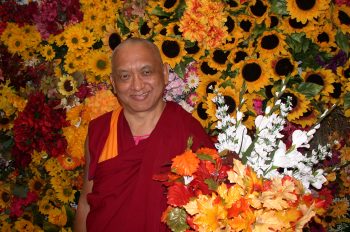
Lama Zopa Rinpoche with flowers, October 2003. Photo by Ven. Roger Kunsang.
This month’s e-news brings you important news, updates, and causes for rejoicing regarding:
- An update on the Stupa of Complete Victory at Kopan Monastery
- Teachings from Lama Yeshe and Lama Zopa Rinpoche
- Meritorious activities on Saka Dawa for the entire FPMT organization
- A report on the Heart Sutra Retreat at Kopan Monastery
- Center and regional news
- Resources for your study and practice
- Opportunities and changes within the organization
and much more!
Please read this month’s e-news in its entirety.
Have the e-News translated into your native language by using our convenient translation facility located on the right-hand side of the page.
Visit our subscribe page to receive the monthly FPMT International Office e-News directly in your email inbox.
- Tagged: enews, fpmt enews
16
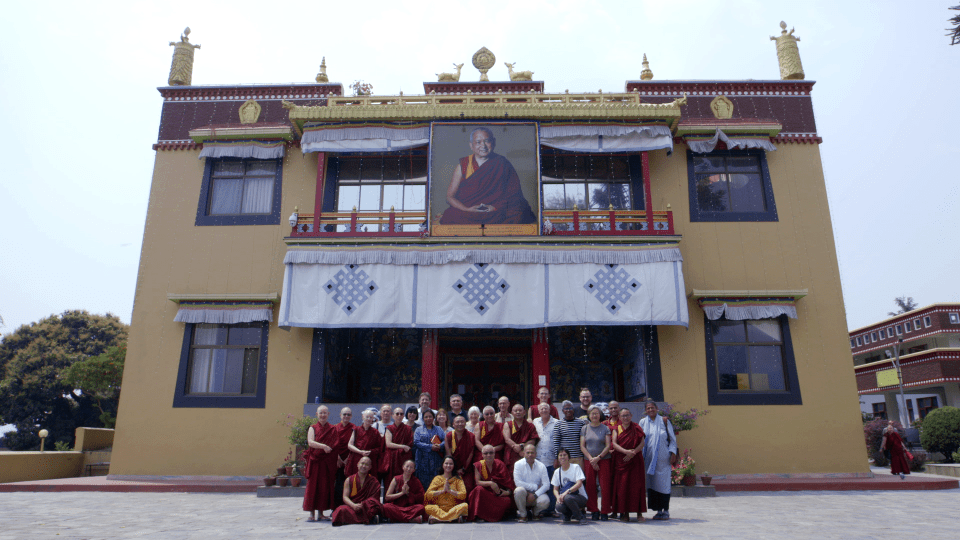
Caption: Group participating in the Asia Regional Consultations at Kopan Monastery. Photo by Kira Dane.
The first of the four regional consultations planned in 2024 to pave the way for the CPMT 2025 meeting took place at Kopan Monastery on April 14-15. Thirty onsite and a dozen online participants joined, representing almost all the centers, projects and services from South Asia and East and South-East Asia, and including eight monks and nuns from Kopan.
Selina Foong, regional coordinator for East and South-East Asia reports.
After seemingly endless regional meetings on Zoom, it felt so right that the first time we met in person again after four long years was at Kopan Monastery… the place where it all began for many of us, and from where ripples of the holy Dharma continue to spread in all directions.
It was a healthy turnout for our regional meeting on April 14 and 15, with all the FPMT East & South-East Asian FPMT centers represented by their respective center directors, Spiritual Program Coordinators, and other key personnel. Those unable to travel to Kopan were equally enthusiastic, joining via Zoom and actively participating in discussions as if they were sitting right next to us in the Kopan Library!
We were thrilled to be joined as well by representatives from South Asia FPMT centers in India and Nepal, including geshes and geshemas from Kopan, during the opening and closing plenary sessions of the meeting, in which Khen Rinpoche Geshe Chonyi and Ven. Roger Kunsang also participated. Together with our meeting facilitators (FPMT board members Karuna Cayton and Dale Davis, and Center Services director Francois Lecointre), this made for a large dynamic group with great camaraderie and family feeling.
The meeting theme was “Advancing our Gurus’ Vision of a World Guided by Compassion & Wisdom” so in between the plenary sessions, we divided into our respective regional groups – ESEA, India. and Nepal – to discuss the way forward for our beloved FPMT organization, progressing on from the FPMT global online survey conducted in early 2024. Rich and fruitful discussions focused on the four main topics: Education, Community Services and Interfaith, Modern Technologies and Communications, and Leadership. Each group was then given the opportunity to present their summaries at the closing plenary session, followed by a delightful buffet lunch in Boudha.
This consultation of the Asian FPMT affiliates from East & South-East Asia, India and Nepal, was the first to be held by FPMT Inc. and International Office, and will be followed by similar consultations in other regions throughout the year which will pave the way for CPMT, due to be held in Kopan Monastery in April 2025. We look forward to it very much. May the unmistaken reincarnation of Kyabje Lama Zopa Rinpoche swiftly return!
The second of the four regional consultations planned in 2024 to pave the way for the CPMT 2025 took place in Jamyang London on April 26-28. Forty onsite participants joined, representing centers, projects, and services from a dozen of European countries. We’ll share more detail on this successful event soon. Next regional consultations are planned in Land of Medicine Buddha for affiliates from North and Latin America, September 6-8; and in Atisha Centre for affiliates from Australia and New-Zealand, October 25-28.
Foundation for the Preservation of Mahayana Tradition (FPMT), is a Tibetan Buddhist organization dedicated to the transmission of the Mahayana Buddhist tradition and values worldwide through teaching, meditation and community service.
- Tagged: cpmt 2025, regional meetings
- Home
- News/Media
- Study & Practice
- About FPMT Education Services
- Latest News
- Programs
- New to Buddhism?
- Buddhist Mind Science: Activating Your Potential
- Heart Advice for Death and Dying
- Discovering Buddhism
- Living in the Path
- Exploring Buddhism
- FPMT Basic Program
- FPMT Masters Program
- FPMT In-Depth Meditation Training
- Maitripa College
- Lotsawa Rinchen Zangpo Translator Program
- Universal Education for Compassion & Wisdom
- Online Learning Center
- Prayers & Practice Materials
- Overview of Prayers & Practices
- Full Catalogue of Prayers & Practice Materials
- Explore Popular Topics
- Benefiting Animals
- Chenrezig Resources
- Death & Dying Resources
- Lama Chopa (Guru Puja)
- Lama Zopa Rinpoche: Compendium of Precious Instructions
- Lama Zopa Rinpoche: Life Practice Advice
- Lama Zopa Rinpoche Practice Series
- Lamrim Resources
- Mantras
- Prayer Book Updates
- Purification Practices
- Sutras
- Thought Transformation (Lojong)
- Audio Materials
- Dharma Dates – Tibetan Calendar
- Translation Services
- Publishing Services
- Teachings and Advice
- Find Teachings and Advice
- Lama Zopa Rinpoche Advice Page
- Lama Zopa Rinpoche: Compendium of Precious Instructions
- Lama Zopa Rinpoche Video Teachings
- ༧སྐྱབས་རྗེ་བཟོད་པ་རིན་པོ་ཆེ་མཆོག་ནས་སྩལ་བའི་བཀའ་སློབ་བརྙན་འཕྲིན།
- Podcasts
- Lama Yeshe Wisdom Archive
- Buddhism FAQ
- Dharma for Young People
- Resources on Holy Objects
- Ways to Offer Support
- Centers
- Teachers
- Projects
- Charitable Projects
- Make a Donation
- Applying for Grants
- News about Projects
- Other Projects within FPMT
- Support International Office
- Projects Photo Galleries
- Give Where Most Needed
- FPMT
- Shop
Translate*
*powered by Google TranslateTranslation of pages on fpmt.org is performed by Google Translate, a third party service which FPMT has no control over. The service provides automated computer translations that are only an approximation of the websites' original content. The translations should not be considered exact and only used as a rough guide.The mental pollution of misconceptions is far more dangerous than drugs. Wrong ideas and faulty practice get deeply rooted in your mind, build up during your life, and accompany your mind into the next one. That is much more dangerous than some physical substance.







